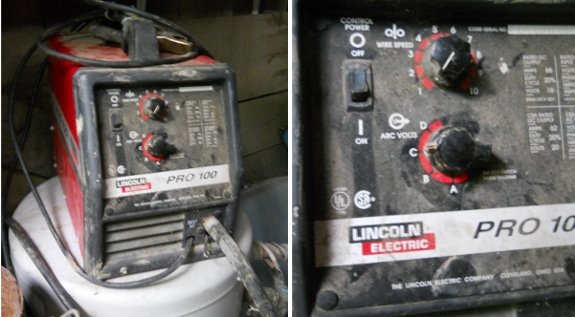
archives for 07/2013
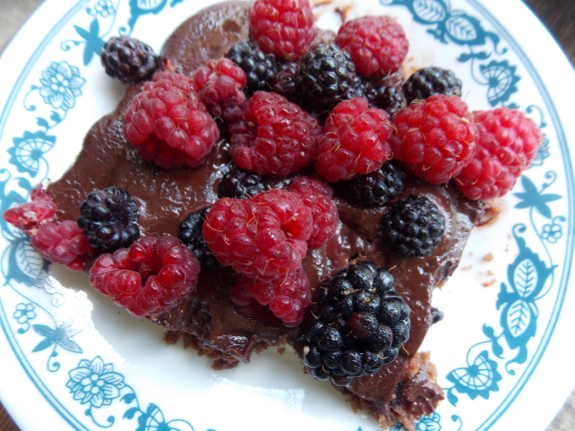
(Photo-shy) friends
came over this weekend, so of course I wanted to feed them
something special. However, I realized the night before that
our bountiful
berries had
just passed their peak and we only had about a quart on the
bushes. How do you make a quart of raspberries feed five
people? Stretch it with chocolate, of course.
Torte
ingredients:
- 0.5 cups of almonds
- 2 ounces of dark chocolate
- 2 tablespoons of butter
- 2 eggs
- 0.5 cups of sugar
- 0.75 cups of flour
- 1 teaspoon of baking powder
- 0.5 teaspoons of salt
- 0.5 cups of raspberries
Topping
ingredients:
- 0.25 cups of heavy cream
- 6 ounces of dark chocolate
- 3.5 cups of raspberries
Preheat the oven to
350 degrees Fahrenheit and butter a 9-by-13-inch cake pan.
Toast the almonds
until they're lightly brown, then grind them for about 5 minutes
in a food processor until the nuts start to release their
oils. Meanwhile, melt the chocolate and butter in the
microwave.
At the same time,
beat the two eggs until they're fluffy. Add the sugar to the
eggs and continue beating. Then mix in the almond paste,
butter-and-chocolate mixture, flour, baking powder, and
salt. Once the batter is thoroughly mixed, lightly fold in
the raspberries, trying not to break them apart.
Pour the batter into
the pan, spread to cover the whole bottom, then bake until a knife
comes out clean. (This won't take long since the batter is
such a thin layer. I didn't time it though; sorry.
Maybe 10 minutes?)
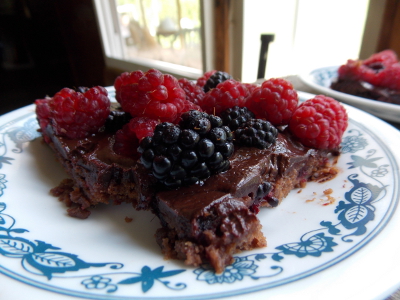 While the cake is baking, heat the cream in a
saucepan over medium-high heat until it just boils. Remove
from the heat, stir in the chocolate, and continue stirring until
the chocolate melts and mixes with the cream.
While the cake is baking, heat the cream in a
saucepan over medium-high heat until it just boils. Remove
from the heat, stir in the chocolate, and continue stirring until
the chocolate melts and mixes with the cream.
Once the cake is
done, spread the chocolate-and-cream mixture over top, then
sprinkle on fresh raspberries generously. (We had a couple
of blackberries and included them, and I'll be blueberries would
be equally delicious.) Cool for a few hours to set the
chocolate.
Serves about 10 and
combines the taste of fresh and cooked raspberries with rich
chocolate and nutty almonds, with none of the flavors overwhelming
the others. Definitely a favorite for fresh-fruit and
dark-chocolate lovers like me!
(Based loosely on this
recipe.)
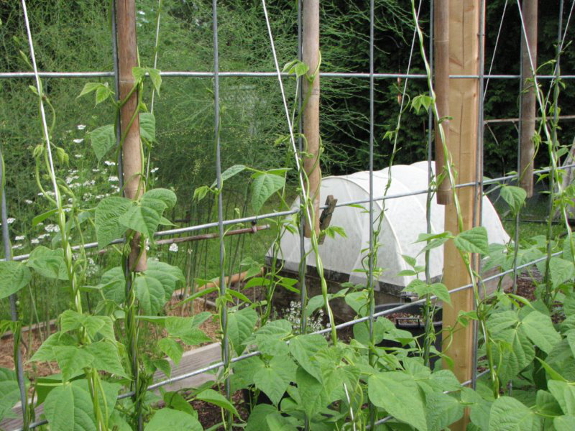
One of our most-read
posts is a reader's
rebuttal to my
square foot gardening lunchtime series. This weekend, Ron
sent me a followup detailing the next three years of his gardening
trials. I'll let him tell you about the seven-year-old,
square-foot garden in his own words.
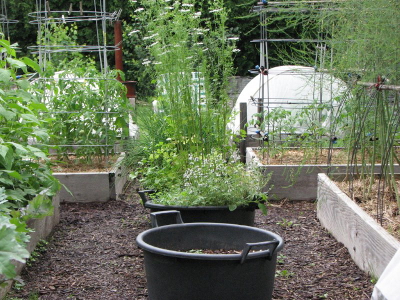 If there is any interest,
I would like to add some up-to-date information on my square foot
garden and offer some answers to raised questions.
If there is any interest,
I would like to add some up-to-date information on my square foot
garden and offer some answers to raised questions.On this date, June 29, 2013, I now have 19 square foot garden beds (last reported was 13 - I've added six, 3' x 8' beds). This is so addicting!!! I am now in my seventh year.
In the garden area, the grass is now gone (covered by newspaper, cardboard, mulch and woodchips). I found the constant mowing, trimming and pulling of weeds a waste of time and a real pain. The most recent benefit is when the latest storms hit, my soil became a "mosh pit" of clay while the mulched area was well drained and workable.
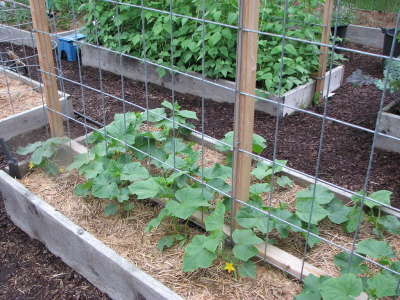 Your readers have a real
fascination with my bamboo trellis. It was made from a childhood
memory of an old Italian gardener neighbor. Somewhat a testament
to him. He truly loved his garden and would always go that
extra mile to make things, just right, just so. This memory goes
back to the 60's.
Your readers have a real
fascination with my bamboo trellis. It was made from a childhood
memory of an old Italian gardener neighbor. Somewhat a testament
to him. He truly loved his garden and would always go that
extra mile to make things, just right, just so. This memory goes
back to the 60's.It took me hours to construct and was based on using 8 foot sections of bamboo, jute twine and a refamiliarization of an old Boy Scout handbook with lessons on "rope lashing." After a couple of hard Upstate New York winters, the jute rotted and had to be constantly maintained.
Needing something more beefy and multifunctional, I discovered cattle fencing with wood framing. Since my standard beds are 3' x 8', I can simply unbolt my frames from the beds and use elsewhere (crop rotation). I am also am a user of 24" Texas Tomato cages. With them, in a 4' x 4' bed, I can plant 16 each saladette or cherry tomato plants and not have them tumble over with the weight of hundreds and hundreds of tomatoes.
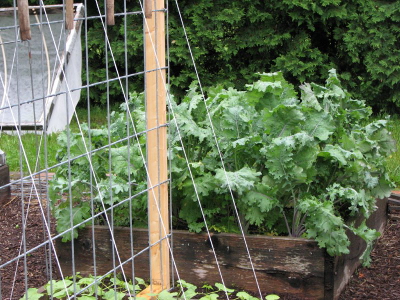 In one 3' x 8' bed, I have
24 cucumber plants started and growing totally vertical. That's
one plant per square foot.
In one 3' x 8' bed, I have
24 cucumber plants started and growing totally vertical. That's
one plant per square foot.Yes, the elegant bamboo frame is now gone (not really, taken apart and repurposed). I still enjoy the memory of making it and the images of my old Italian neighbor in his garden who spent the majority of his day there tending it and feeding his family.
I constantly experiment. The cardboard boxes in the beds shown, were in fact, the mini planting areas for fingerling potatoes. The boxes allowed me to bury deep and by stacking another, I could hill the potatoes higher by adding another cardboard box. Did it work, yes, but not really a sure winner of an idea. Win some, lose
some.
This year experiments include 3 full 3'x8' beds of fall planted hard neck rocambole garlic. I have added Azomite, kelp meal, and I just started spraying compost tea to this years' crop. Shortly, I hope to obtain rabbit manure, compost it, and then add red wigglers for their castings. All to add to the beds in the fall. It's all about building up the soil.
We are now deep into canning, freezing, and dehydrating. This year's garlic scape pesto is beyond belief!
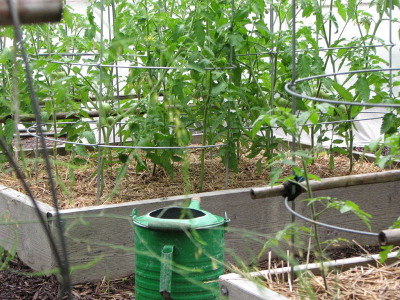 As a reminder, I live in
suburbia. My neighbors pray to the ChemLawn Gods. "Why grow
your own when a grocery store is a half mile away?" So
sayeth the neighbors. Frankly, trying to live a sustainable
lifestyle up here is a hard sell with this bunch. Wait when they
see the chickens in a few years!
As a reminder, I live in
suburbia. My neighbors pray to the ChemLawn Gods. "Why grow
your own when a grocery store is a half mile away?" So
sayeth the neighbors. Frankly, trying to live a sustainable
lifestyle up here is a hard sell with this bunch. Wait when they
see the chickens in a few years!I believe, loosely, with slight modifications, square foot gardening works and is legitimate method for all experience levels based on their available land, soil conditions and neighborhoods. I will also note and praise, I envy your lifestyle and your more rural conditions.
Would also like to add, in addition to the methods used by the Dervaes family, I would also recommend and make mention to your readers to watch the Youtube videos of Laszlo Horvath and GrowingYourGreens. They have taken suburban square foot gardening to new levels and demonstrate its viability.
Best wishes from Upstate New York.
--- Ron
Anna and I have been talking
about the sunroom
addition and we both
realized at the same time that we don't eat as many lemons as we once
did. I gave up Iced Tea a couple of years ago when I discovered most black
teas have high amounts of Fluoride due to chemicals used in the
growing process.
We had some friends over
recently and they happily agreed to give our Myers
Lemon tree a good home.
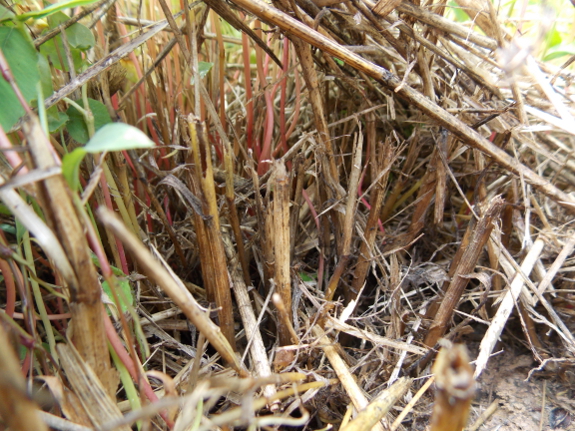
I haven't regaled you
with tales of cover crops in a while, but that
doesn't mean we haven't been experimenting. First of all, cutting
rye with the weedeater right at ground level was highly effective, although my
scything a little higher up resulted in some resprouting.
The plants we cut early, just as they were barely starting to
bloom, were also more likely to resprout. A final warning
--- the rye did hold onto nitrogen much harder than any other
cover crop I've grown, so a few broccoli sets I transplanted
directly into manure poured on top of the stubble took a week or
two to really start getting the nutrients they needed. But,
overall, we were very pleased with our rye experiment and will
definitely repeat it, especially in problematic soil areas where
the rye built masses of organic matter.
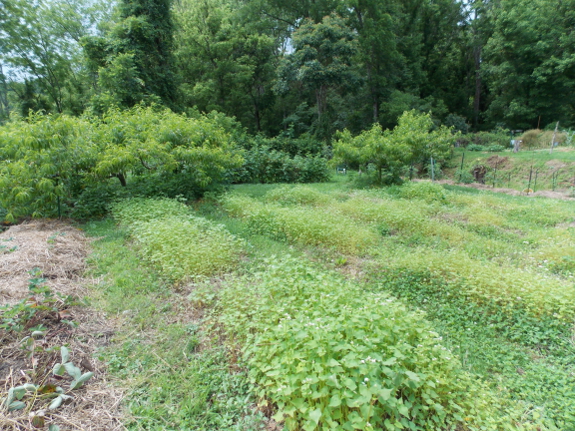
Most of the back
garden is fallow this year as I prepare
it for next year's tomato crop, so I broadcast buckwheat seeds into the rye before
Mark cut it. Mark and I both spread our pee on certain areas
for a week or so (until the buckwheat started sprouting) to add
nitrogen to the ground, but the buckwheat is struggling. It
definitely came up well through the rye stubble, but I've always
had a problem getting much growth out of buckwheat in areas with a
very high groundwater, and this year is no exception. We'll
get a bit of growth out of the back garden buckwheat, but I'm
thinking of trying some sunflowers next.
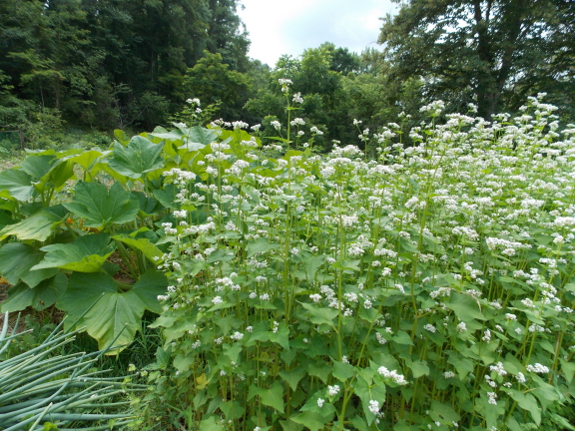
In contrast, the
buckwheat I've planted into good garden areas is over twice as
large and is thriving. I've already made inroads into my buckwheat
challenge,
having planted about 4.5 gallons of seed so far this spring and
summer.
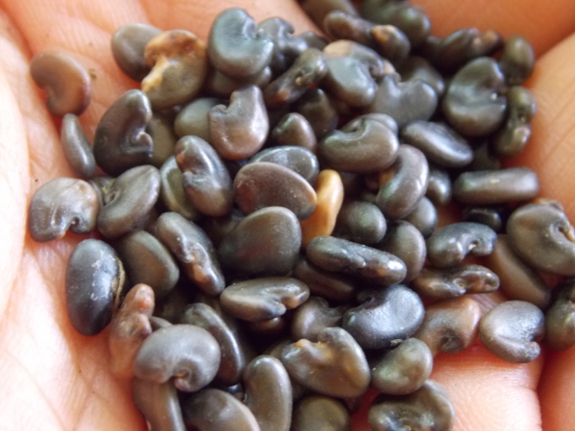
But our big
experiment came into my inbox as a whim. Harvey
Ussery is
testing out sunn hemp (Crotalaria juncea), and wanted to send out
samples to his readers for us to try in different parts of the
country. This legume gets up to eight feet tall and produces
huge amounts of biomass before frosts kill the plants in the
fall. You can cut the plants at 60 days as a high-nitrogen
addition to the garden or compost pile, or wait a bit longer, at
which point the carbon levels rise and sunn hemp becomes a quality
mulch. In addition, cutting the plants once at four feet
tall results in resprouting and even more biomass
production. I slipped the seeds into gaps in the forest
garden where broccoli was coming out, and I envision the
high-carbon stems at the end of the year will make good mulch
around fruit trees. I'll keep you posted about the results
of my experiment, and you'll be able to read how sunn hemp did for
us and other experimenters this fall or winter in an article by
Harvey Ussery in Mother Earth News.
We recently noticed our first
deer damage of the year.
It's hard to know for sure,
but we think she came in through our weakest fence line.
Weed eating around the fence
and repairing the weak spot might help to make this deer think twice
before coming in, but it might also be time to ask the local Game
Warden for another deer
killing permit.
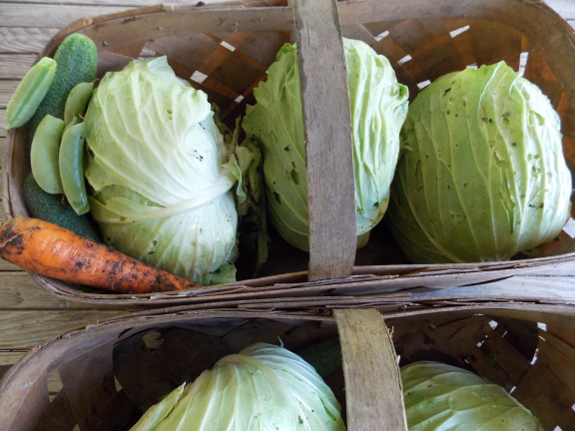
It's been a while
since I've written a sumup of the garden, which is mostly because
both the produce and the weeds are growing like crazy.
Broccoli and pea season has come and gone. For about a week
in the middle of June, the broccoli heads became so full of
southern cabbageworms that I barely wanted to cook them, but then
the checkered white butterflies stopped laying eggs, and recent
heads have been pristine. (The more common cabbage
worms from the cabbage white are still around in small
numbers, but they're not nearly as big of a deal for us.)
These early crops
were quickly replaced by cucumbers, which immediately began to
overwhelm us to the point where we had to give extras away.
Although I could cut back on my planting next year, it's nice to
have a quick, easy vegetable that scales up to feed an unlimited
number of mouths on a moments' notice, so I probably won't scale
down.
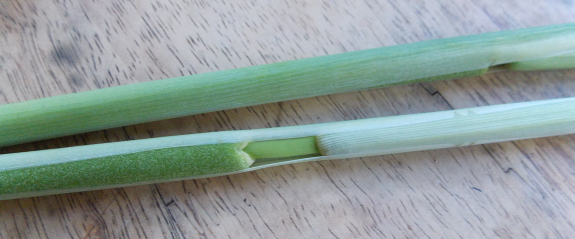
We're also enjoying
yellow crookneck squash, green beans, and the first huge cabbage
heads. Monday, Mark and I sampled cattail flowers for the
first time, which you're supposed to pick when they're still
enclosed in their sheath, remove from their husk, boil for 3
minutes, then eat like corn on the cob. Although Eric in
Japan reported cattails taste like avocadoes (one of our favorite
storebought addictions), Mark and I were less than impressed by
the cattail heads and deemed them mere survival food.
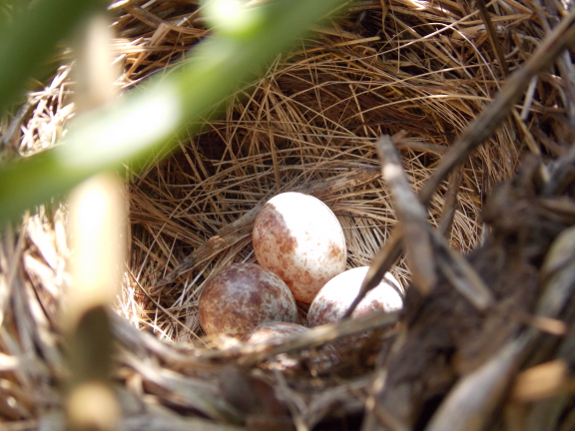
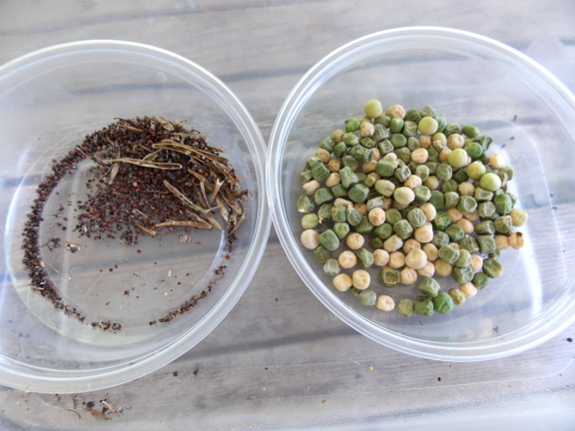 While waiting for the tomatoes to ripen
(which will mark the beginning of major preservation season),
we're staying busy planting late crops, renovating
the strawberry beds, weeding, mowing, and saving
seeds (kale, tokyo bekana, and peas so far). The kale
plants I left to go to seed are so vigorous, I'm considering using
the vegetable as a cover crop in areas that don't need to be
planted until mid summer, and the dying plants are still doing
double duty by sheltering a song sparrow nest. Kale plants
that have already given me their quota of seed (and that aren't
housing wildlife) made good deep bedding in the chicken coop.
While waiting for the tomatoes to ripen
(which will mark the beginning of major preservation season),
we're staying busy planting late crops, renovating
the strawberry beds, weeding, mowing, and saving
seeds (kale, tokyo bekana, and peas so far). The kale
plants I left to go to seed are so vigorous, I'm considering using
the vegetable as a cover crop in areas that don't need to be
planted until mid summer, and the dying plants are still doing
double duty by sheltering a song sparrow nest. Kale plants
that have already given me their quota of seed (and that aren't
housing wildlife) made good deep bedding in the chicken coop.
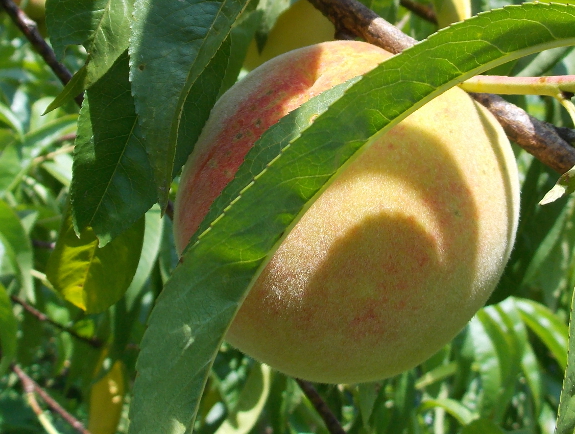
It continues to rain
nearly every day, but so far I haven't seen the fungal diseases
I've been dreading. Our first peaches (Redhaven) are already
thinking of ripening up, and despite insect damage to many fruits,
I suspect we'll enjoy a bountiful crop.
How's your garden
doing now that summer is officially here?
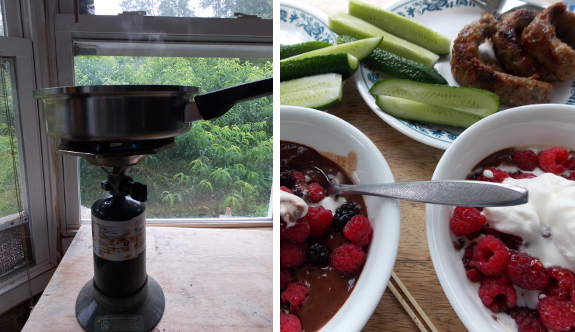
Aerial line maintenance has caused two power outages this week.
A short summer power
outage is no big deal, though. Anna whipped up supper on the
camp stove and we enjoyed an afternoon of quiet.
It does remind us to check
back over our emergency
preparedness goals. We've come a long way, but still
have several items to check off the list.
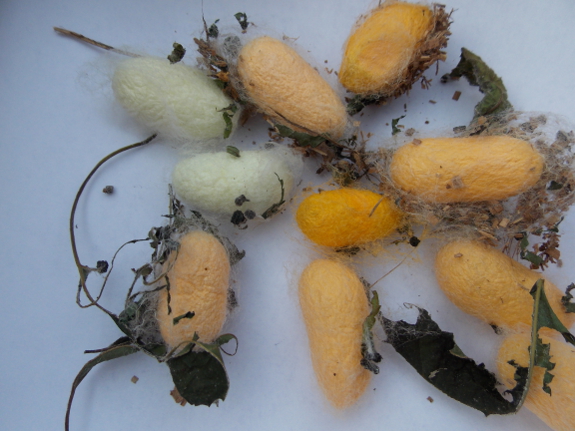
Due to some dieoff
during our final
silkworm week,
we ended up with only ten silkworm cocoons, but that should be
enough to carry our livestock on to the next generation. I
was amazed by the colors of the cocoons, especially the brilliant
orange one that almost looks fake. My understanding is that
commercial silkworm producers select for white cocoons so that
they don't have to bleach the silk before dying it.
One of our chicken blog readers wrote in to ask
if she could have our cocoons after we're done with them, which
made me realize it's far from common knowledge how silk is
produced. Unfortunately, you have to decide whether to use
your cocoons to make silk or whether to let the moths escape and
breed, so our cocoons will end up being useless from a fiber
perspective.
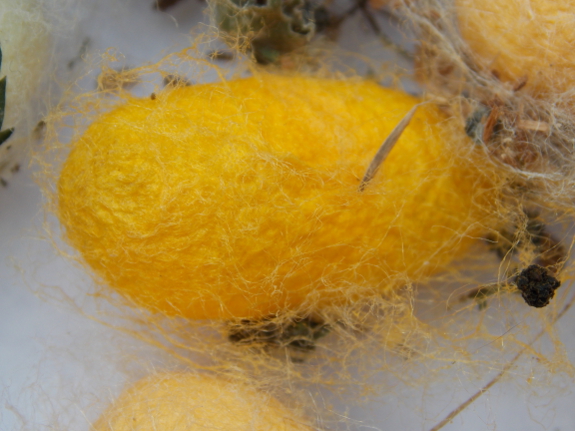
If you're not trying to
breed the moths, though, it is quite feasible to make silk on the
backyard scale if you're up for some tedious labor. Just
boil the cocoons once they're fully formed, which kills the pupae
inside and dissolves the glues binding the silk together.
Each cocoon is made up of one extremely long strand, which you can
tease apart and wind up, then weave like any other thread.
The reason you can't raise the moths and still use the thread is
that the mature insect gnaws its way to freedom, breaking that
long thread into many smaller pieces that are much less useful.
Mark and I are still
on the fence about whether silkworm culture is an efficient use of
time, but we're definitely going to breed our moths and start
tweaking the procedure so it works better. Stay tuned for
round two, coming up next month.
We celebrated Independence Day with some bucket
hauler sparks.
I used 16 heavy duty exterior wood screws for a second attempt at plywood
attachment.
They ended up protruding through the plywood side and needed to be
grinded off to achieve a smooth surface. I also used 4 bolts with
washers and nuts to be on the safe side. The nut side sticks out a bit,
but I located each hole so it fits in a gap between buckets.
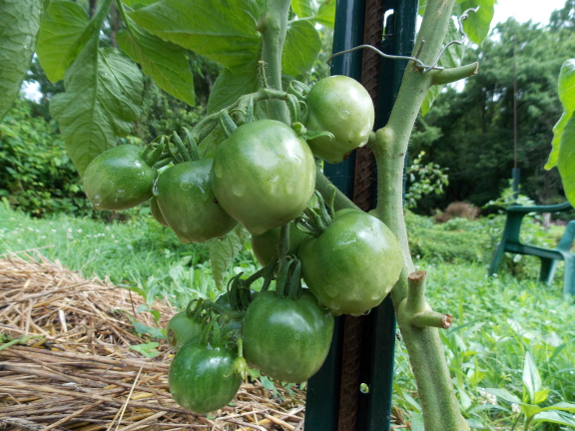
The interest in Mark's
post about fighting tomato blight with pennies has been
astounding. Even though I'm dubious about pocket change's
effect on fungal diseases, that post's popularity made me decide
to experiment with a slightly different form of copper.
My budget for the
project was the $80 we've made in ad revenue from folks coming to
check out our tomato blight post, but I tacked on another $10 so I
could try two types of copper --- this
expensive and high-quality copper screen and this
ultra-cheap mesh.
Mark cut the screen into eight sections (each of which was a foot
square with a 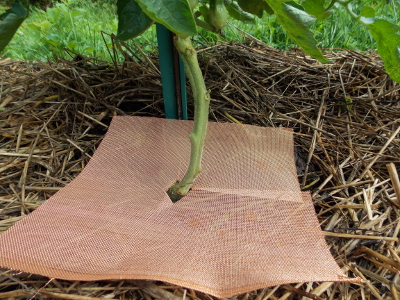 notch to allow the screen to slide around the
tomato stem), and I cut the mesh into four lengths that cover
about the same area. My test subjects consisted of a row of
yellow romas, where I alternated control (no copper), mesh, and
screen beneath subsequent plants.
notch to allow the screen to slide around the
tomato stem), and I cut the mesh into four lengths that cover
about the same area. My test subjects consisted of a row of
yellow romas, where I alternated control (no copper), mesh, and
screen beneath subsequent plants.
The theory is that
the anti-fungal properties of copper will prevent fungal spores
from being splashed up from the soil line into the lower leaves
(where blight usually first takes hold of a tomato plant).
Organic farmers sometimes 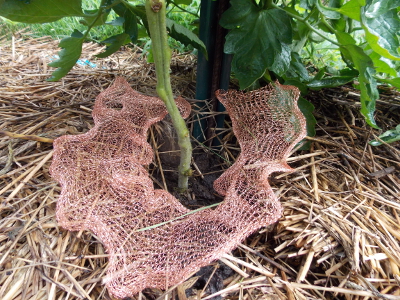 use powdered copper on tomatoes for this
purpose, but that technique is dicey from a permaculture
standpoint since the powdered copper gets into the soil and kills
beneficial fungi as well as disease-causing species. Only
time will tell whether a solid copper mesh will serve the same
purpose without the harm to ecosystem life.
use powdered copper on tomatoes for this
purpose, but that technique is dicey from a permaculture
standpoint since the powdered copper gets into the soil and kills
beneficial fungi as well as disease-causing species. Only
time will tell whether a solid copper mesh will serve the same
purpose without the harm to ecosystem life.
We got the ATV back from the shop last week and
it's better, but not quite fixed.
The problem was no brakes. We
had the back pads replaced and made sure the front pads had enough life
in them.
It slows down, but I have to
pump the brake handle and be careful not to hit anything. I think maybe
the caliper got damaged and we may have to plan on having it replaced
in the future, but for now we'll get by with half brakes so we can get
caught up on manure hauling.
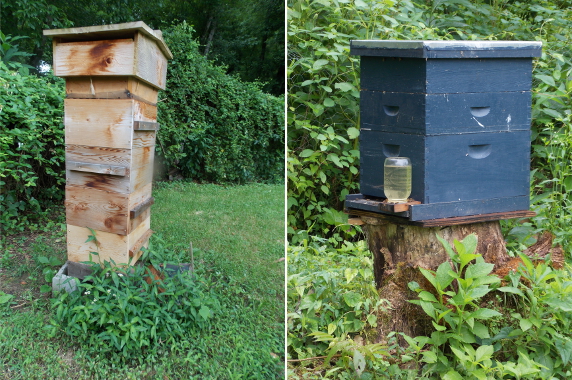
I hadn't really
intended to get back into Langstroth beekeeping anytime soon, but
when
the bees speak,
I listen. I figured I might as well leave our new swarm in
the boxes they chose...with a few modifications.
My first step in the
modification process was to brainstorm the primary features of a Warre hive, and ways I might easily
modify the Langstroth hive to serve the same purpose:
| Warre hive
feature |
Purpose |
Possible
retrofit to Langstroth |
| Quilt |
Insulation and winter drip
prevention |
Modify an extra super to
become a quilt. (Easy.) |
| Fancy roof |
Air flow? |
Built a similar roof.
(Hard.) |
| Small entrance |
Not positive, but bees select
for this in the wild, so it must be important, perhaps in
guarding the hive and/or maintaining Nestduftwarmebindung. |
Entrance reducer. (Easy.) |
| Thick hive walls |
Insulation |
Rebuild boxes out of thicker
boards. (Hard.) |
| Top bars |
Prevent varroa mites using
small cell size. |
Foundation
strips. (Easy.) |
| Smaller boxes |
Winter temperature
maintenance? |
(I don't like the idea of
using all supers instead of deeps, which would be easy, and
am not sure this is actually an important feature of the
Warre hive.) |
| Hive opened only once a year |
Maintain Nestuftwarmebindung
and don't make bees waste propolis. |
Raise up base of hive so I
can photograph underneath and monitor bees' progress that
way. (Moderate.) |
| Nadiring |
A subset of the feature
above. |
Add larger handles on sides
of the boxes so entire hive can be raised at once for
nadiring. (Easy.) |
| Allow swarming |
Creates a break in disease
cycle. |
Don't use swarm
prevention techniques. (Easy. But, this is
one feature of a Warre hive I might consider ditching in the
long run since it drastically reduces honey
production. The health of the bees is my first
priority, though, so I'm keeping it for now.) |
| Queen works throughout hive. |
Allows cycling of wax if you
crush and strain, which prevents disease. |
Don't use excluder, do nadir,
and remove honey from top. (Easy.) |
Once we get a spare
minute in the garden, I plan to apply the easiest of these
features to our Warre hive, notably the quilt and raising the box
up so I can slide my camera underneath. (I already installed
foundation strips so the bees will build most of their own
wax.) The bees shouldn't need to be nadired this year since
they already have the equivalent of four Warre hive boxes, but
Mark and I will plan to suit up (or wait until winter) and add
handles to the boxes before next spring. It will be
interesting to see whether a Langstroth hive with a few simple
modifications will be as effective as the more expensive and less
common Warre equipment.
There's fuzzy evidence that a
deer is still sneaking in at night...but the damage lately has been
minimal.
I was happy to see one of the
old mechanical
deer deterrents start up
with no problem, although it didn't seem to stop this one...but maybe
the noise shortened her stay.
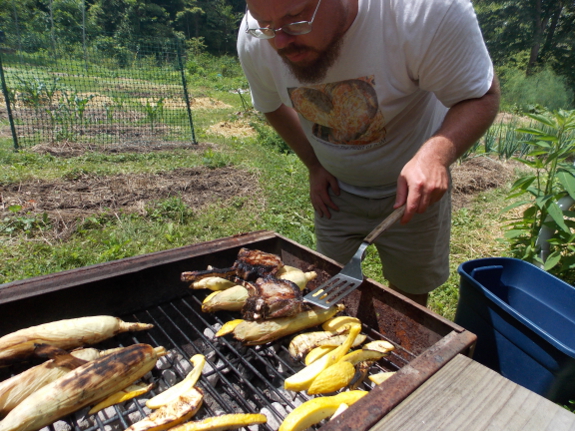
Joey brought over
four pork chops and threw them on the grill, along with some of
our overabundant summer squash and some storebought corn.
The pork chops were pastured, brined overnight in an
herb-salt-and-water solution, then cooked a bit faster than we'd
planned. (In the photo above, Joey's letting them finish off
atop some ears of corn to get the meat further away from the
heat.)
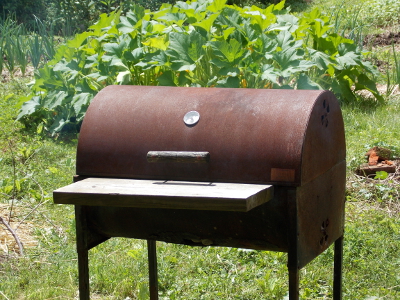 I'd never tasted pastured pork before, but every other
pastured meat I've tried has been ten times better than feedlot
produce. So I shouldn't have been surprised that this pork was
also phenomenal. We'll definitely be making an order of our
own soon.
I'd never tasted pastured pork before, but every other
pastured meat I've tried has been ten times better than feedlot
produce. So I shouldn't have been surprised that this pork was
also phenomenal. We'll definitely be making an order of our
own soon.
Meanwhile, if you
live in or near Rogersville, Johnson City, or Knoxville,
Tennessee, J.E.M. Farm likely delivers to your
town and even offers a CSA. I'm looking forward to a field
trip to tour their operation once our own garden slows down for
the year.
We used some basic tin snips
to cut the copper
screen material into
squares.
If I do this again I'll
remember to wear gloves to avoid being cut from the sharp edges.
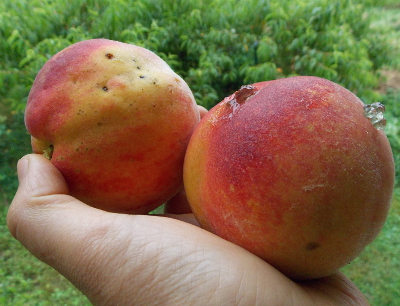 Every time I looked at the
huge, red-blushed peaches on our Redhaven tree last week, I
reminded myself the chances of eating any were slim to none.
We'd seen the sun for about ten hours of that week and had enjoyed
rains at least once a day, so I knew brown rot would set in before the
fruits ripened.
Every time I looked at the
huge, red-blushed peaches on our Redhaven tree last week, I
reminded myself the chances of eating any were slim to none.
We'd seen the sun for about ten hours of that week and had enjoyed
rains at least once a day, so I knew brown rot would set in before the
fruits ripened.
Sure enough, Friday I
noticed a rotting peach in the center of the tree. I removed
it, but by Sunday, five more peaches had come down with the fungal
disease. Unless the weather miraculously stops thinking we
live in a rain forest, I suspect each fruit will succumb as it
builds up enough sugars to feed the fungus.
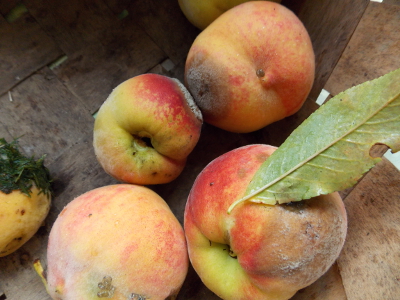 In the meantime, I'm
trying out some mitigating measures. The first year we
fought brown rot, I didn't know what it was and wasn't paying
attention, with the result that we basically got no crop.
This time around, I'm using the same techniques I use on other
fungal diseases --- an eagle eye and removal of infected tissue as
quickly as possible. The jury's still out on whether that
will allow at least a few peaches to ripen to perfection on the
tree.
In the meantime, I'm
trying out some mitigating measures. The first year we
fought brown rot, I didn't know what it was and wasn't paying
attention, with the result that we basically got no crop.
This time around, I'm using the same techniques I use on other
fungal diseases --- an eagle eye and removal of infected tissue as
quickly as possible. The jury's still out on whether that
will allow at least a few peaches to ripen to perfection on the
tree.
Meanwhile, I'm also
experimenting with ripening up peaches inside. Granted, I've
read that peaches don't really ripen off the tree, but merely
soften. Still, I suspect they'll be at least as good as
storebought fruit, and will definitely be better than
nothing. The question is whether the brown-rotted fruits
(with the bad spots cut out) will ripen in the fridge, or whether
I need to pick fruits before they're infected. I'm trying a
few of each to see.
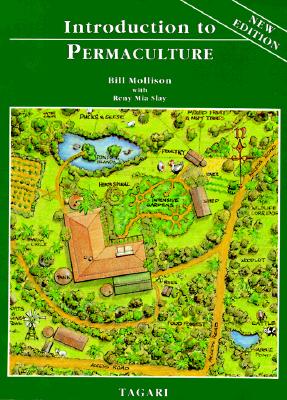 I have to confess that my
grand plan of slowly working through both Gaia's
Garden and Introduction
to Permaculture
in tandem with Will
Hooker's online permaculture course fell by the wayside. My edition of
Mollison's book didn't have the right page numbers, and it was
more interesting than either of the other information sources, so
I zipped ahead to finish Introduction to
Permaculture
before listening to more lectures or reading more of Gaia's Garden.
I have to confess that my
grand plan of slowly working through both Gaia's
Garden and Introduction
to Permaculture
in tandem with Will
Hooker's online permaculture course fell by the wayside. My edition of
Mollison's book didn't have the right page numbers, and it was
more interesting than either of the other information sources, so
I zipped ahead to finish Introduction to
Permaculture
before listening to more lectures or reading more of Gaia's Garden.
Which is all a long
way of saying --- even though I didn't get into Mollison's book
when I first tried it several years ago, I now consider Introduction to Permaculture
to be the best way for those new to permaculture to get a
sampling of dominant ideas in the field. You'll be
introduced to Salatin-style grazing, greywater management, no-till
gardening, and much more, and will be inspired by line drawings
that make you want to jump out there and put some of these ideas
into action. And while I'm usually dubious of books that
contain no photos (is this all just philosophizing, or has the
author actually tried it?), Mollison is clearly a doer who seasons
his text with 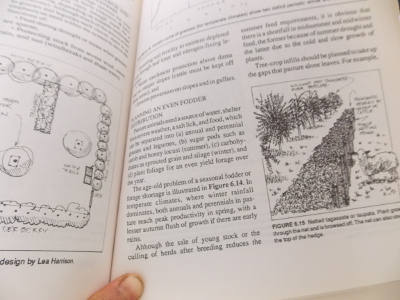 warnings about when each
project is likely to succeed or fail. 90% of the time, I
even agree with him, even though Mollison gardens in dry Australia
and I garden in wet Appalachia.
warnings about when each
project is likely to succeed or fail. 90% of the time, I
even agree with him, even though Mollison gardens in dry Australia
and I garden in wet Appalachia.
Stay tuned for some
of the highlights of Bill Mollison's book later in this week's
lunchtime series, and consider dropping by our chicken blog later in the week where
I'll be relating Mollison's tips for grazers. Or, if you're
just tuning in, you might be interested in this post from a few
weeks ago about Mollison's
approach to forest gardening.
| This
post is part of our Mollison's
Introduction to Permaculture lunchtime series.
Read
all of the entries: |
We noticed more deer damage
this morning but this time we were able to follow her trail to a spot
where we think she might be jumping over the fence.
It's a spot where we don't
have a chicken
moat.
Using two tall trees to
attach to we were able to double the fence height on that section from
5 feet to 10 feet.
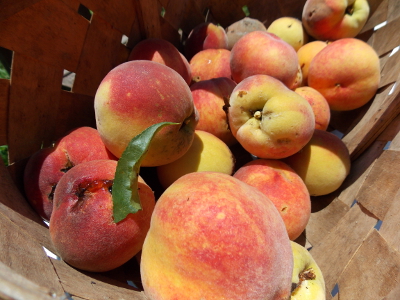 "Why not just give in and
spray high risk crops with Neem Oil (or whatever fungicide you are
comfortable with)?" --- Robert
"Why not just give in and
spray high risk crops with Neem Oil (or whatever fungicide you are
comfortable with)?" --- Robert
I get this question a
lot, or the related "Why don't you just spray an
insecticide?" Folks familiar with organic gardening are used
to "safe" sprays like neem oil that do many of the same jobs as
non-organic pesticides or fungicides. But my philosophy is a
little different.
No matter how
specific you think your organic spray is, it's going to do damage
to beneficials in the same category as the problem species you're
trying to combat. The question is, are you willing to harm
the fungi in the soil that help your trees suck up micronutrients,
resulting in a tree that's going to need more help every
year? How about if that also means the food from the tree is
going to be less nutrient dense? Basically, by spraying
organic killers of any kind, I'd be going back to
storebought-produce quality, and the goal of growing our own is to
feed ourselves tastier and more nutritious food than we could buy
in any store.
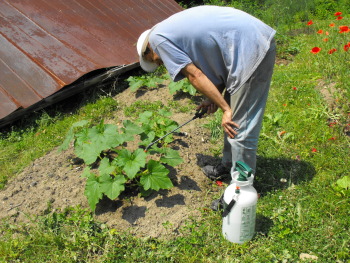 Without chemicals, you have to be a bit
smarter, willing to experiment, and able to handle failures.
In some cases, we've come up with systems that work perfectly for
our climate. For example, instead of spraying Bt
to prevent the dastardly vine
borers that pretty much kill all squash in our region, I now
take a multi-prong (but chemical-free) approach. First, I
chose varieties that are less tasty to vine-borers (butternut
squash and yellow crookneck squash), which solves the problem for
the winter squash entirely. With summer squash, even the
crooknecks succumb to the vine borers eventually, but as long as I
plant a new bed of squash every two weeks in the summer, we
still end up giving bagsful away.
Without chemicals, you have to be a bit
smarter, willing to experiment, and able to handle failures.
In some cases, we've come up with systems that work perfectly for
our climate. For example, instead of spraying Bt
to prevent the dastardly vine
borers that pretty much kill all squash in our region, I now
take a multi-prong (but chemical-free) approach. First, I
chose varieties that are less tasty to vine-borers (butternut
squash and yellow crookneck squash), which solves the problem for
the winter squash entirely. With summer squash, even the
crooknecks succumb to the vine borers eventually, but as long as I
plant a new bed of squash every two weeks in the summer, we
still end up giving bagsful away.
In other cases, I
hand pick and (impatiently) wait for the natural predators of pest
insects to show up. For example, we used to be overrun with
asparagus
beetles, but I nearly wiped out their population by
thrice-weekly squashing sessions. This year, I saw some show
up  again for the first time in years, but
after a round of squashing, I started noticing more wheel bugs and
ladybug larvae on the asparagus and no more asparagus beetles.
again for the first time in years, but
after a round of squashing, I started noticing more wheel bugs and
ladybug larvae on the asparagus and no more asparagus beetles.
Fungi don't seem to
have natural enemies (or at least I can't see them with my naked
eye. Some sources suggest that good fungi build up on plant
surfaces and battle the bad fungi for space.) So I plant
blight-resistant varieties, site fungal-prone plants in the
sunniest part of our garden, pluck off fungal damage as soon as I
see it, and trellis plants like cucumbers so they stay away from
the damp ground. And, if worst comes to worst, I rip out
varieties (and sometimes whole species) that can't handle our
damp.
Which is all a long
way of explaining that our peaches are still on probation, and if
I can't find a cultural control for brown rot, I'm willing to let
them go. Sure, they're one of my favorite fruits, but I
could put the same space and energy into more dependable June
apples, blueberries, blackberries, and late raspberries if I have
to. (Hear that peach trees --- either shape up or ship
out!) I'd rather eat healthier, tastier food of a
second-favorite variety than throw chemicals into the ecosystem I
live in and eat out of.
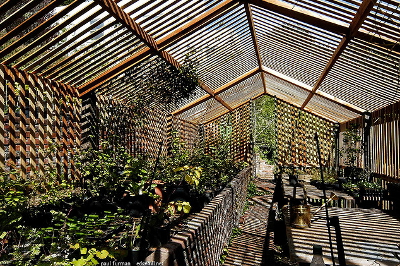 One of my favorite
chapters in Bill Mollison's Introduction
to Permaculture was the one on housing. In addition to
all of the mainstream information on passive solar (with or
without an attached greenhouse), closing and opening windows to
manage air temperature, thermal mass, and shade trees, he
introduced a concept I'd never heard of --- the shade house.
One of my favorite
chapters in Bill Mollison's Introduction
to Permaculture was the one on housing. In addition to
all of the mainstream information on passive solar (with or
without an attached greenhouse), closing and opening windows to
manage air temperature, thermal mass, and shade trees, he
introduced a concept I'd never heard of --- the shade house.
A search of the
internet suggestions that Mollison's shadehouse may sometimes be
known as a lathe house. Regardless of the name, the
structure is placed on the north side of the home in our
hemisphere, has a partially covered top to provide shade, and is
coated with vegetation inside and out. Vines are often
trellised up the sides, and the top may be made of trellis
material to allow the vines to continue their growth there, or it
might consist of multiple layers of snow fencing or one layer of
reflective shade cloth. Water tanks inside or around the
structure can provide extra thermal mass.
The shade house
produces a very cool environment to feed air into the house in the
summer. Opening a high window on the opposite side of the
house (or a vent in the top of an attached greenhouse) lets hot
air escape, then a vent low in the wall attached to the shade
house pulls in cool air from that structure to replace the warm
air.
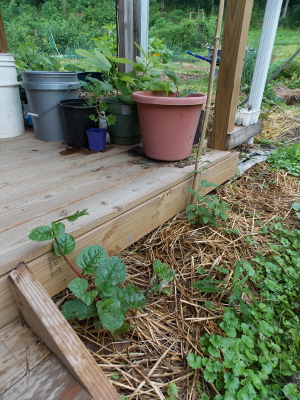 A shade house also provides
other much-needed uses on the summer homestead as well. You
can add an outdoor bathing station, and should definitely consider
raising mushrooms there and rooting cuttings in the shade.
We've yet to find the best environment for mushroom logs in the
summer, and although my cuttings do pretty well in the semi-shade
of the porch edge, I can see how a shade house would make
propagation even easier.
A shade house also provides
other much-needed uses on the summer homestead as well. You
can add an outdoor bathing station, and should definitely consider
raising mushrooms there and rooting cuttings in the shade.
We've yet to find the best environment for mushroom logs in the
summer, and although my cuttings do pretty well in the semi-shade
of the porch edge, I can see how a shade house would make
propagation even easier.
The one thing I'm
unsure of is whether a shade house would make the main house too
moist in our wet climate. Constant rain during summers like
this one mean that fabrics left to dry over chairs in the house
often mold before the water leaves them, and swamp coolers
definitely won't work on our humid farm. Part of the benefit
of shade houses is supposed to be adding humidity to the air, so
maybe they're not compatible with our area after all?
| This
post is part of our Mollison's
Introduction to Permaculture lunchtime series.
Read
all of the entries: |
No deer damage last night,
but we're still shoring up our perimeter.
This new gate will rule out
the possibility of her walking in the way we enter.
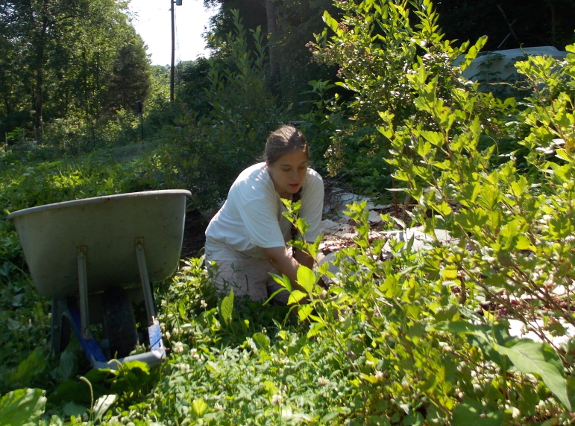
"Are you Anna Hess's
husband?" asked the clerk at one of the local hardware stores Mark
frequents. Mark admitted that he was, indeed. "My
daughter's been reading your
wife's book.
The library wants it back, but she's not done with it. Do
you think she could buy a copy from you?"
"I've got a better
idea," Mark answered. "Would she like a job?"
Which is all a long
way of explaining how Kayla showed up on our doorstep a month or
so ago. She's an industrious helper who doesn't get bored
when I ask her to weed all morning, she's genuinely interested in
all of my crazy garden experiments, she can handle slogging
through the mud to get to work, and (best of all) she has a large
enough extended family to eat all of our extra cucumbers and
summer squash.
I've decided the
paperback experiment was a total success. If it takes
writing a book to find a helper like Kayla, it's worth every
minute at the keyboard.
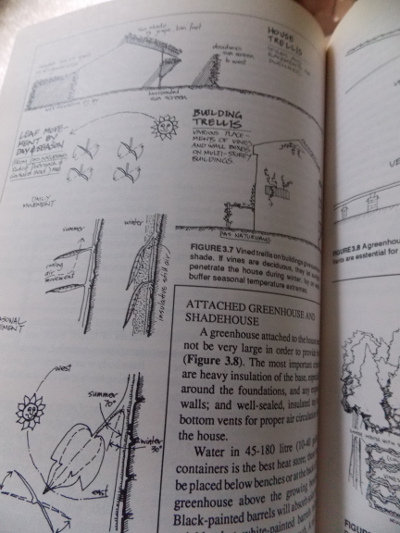 Of course, the tips from
Mollison's book that I'm most likely to put into action pertain to
plants and ecosystems. I especially enjoyed the way Mollison
suggested alternative uses for features I'd already
considered. For example, I tend to deal with my boggy ground
by building up so I can plant there, but perhaps I should instead
dig out some areas to create open water. (The swamp downhill
from the East Wing might be a good location for
bog-to-shallow-pond experimentation.) And Mollison suggests
considering hedges to be mulch sources and weed barriers as well
as animal barriers and producers of food.
Of course, the tips from
Mollison's book that I'm most likely to put into action pertain to
plants and ecosystems. I especially enjoyed the way Mollison
suggested alternative uses for features I'd already
considered. For example, I tend to deal with my boggy ground
by building up so I can plant there, but perhaps I should instead
dig out some areas to create open water. (The swamp downhill
from the East Wing might be a good location for
bog-to-shallow-pond experimentation.) And Mollison suggests
considering hedges to be mulch sources and weed barriers as well
as animal barriers and producers of food.
Meanwhile, Mollison
goes into depth about using plants to mitigate heating and cooling
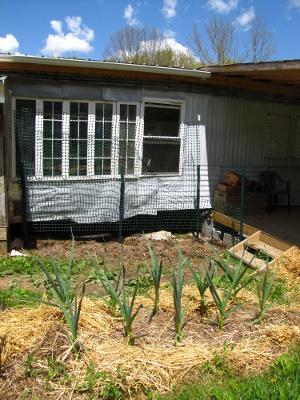 issues around your
home. While deciduous shade trees are great, we just don't
have room for such a large plant on the south side of our trailer
--- a maple would take up half the garden (and would impact the
powerline). But I've been planning to trellis vines against
the south side of the porch and trailer instead, and Mollison
heartily approves of the idea. My
first attempt this spring with annual vines failed because
it turns out that the soil there is very wet and clayey, so I'm
dumping masses of weeds in the spot this summer to raise the soil
up and increase the organic matter content in preparation for fall
planting of some kind of perennial vine (probably home-propagated
grapes).
issues around your
home. While deciduous shade trees are great, we just don't
have room for such a large plant on the south side of our trailer
--- a maple would take up half the garden (and would impact the
powerline). But I've been planning to trellis vines against
the south side of the porch and trailer instead, and Mollison
heartily approves of the idea. My
first attempt this spring with annual vines failed because
it turns out that the soil there is very wet and clayey, so I'm
dumping masses of weeds in the spot this summer to raise the soil
up and increase the organic matter content in preparation for fall
planting of some kind of perennial vine (probably home-propagated
grapes).
On a related note,
did you know that hanging plants are supposed to cool the
surrounding area? I'd always thought the pots of dangling
ferns I notice in southern homes and porches are just for
aesthetics, but I can see how the plants might do their part in
keeping conditions comfortable nearby. Similarly, all those
fountains in Mediterranean countries are meant to add humidity
(and thus coolness) to the air, while ivy growing over buildings
is reputed to reduce heat 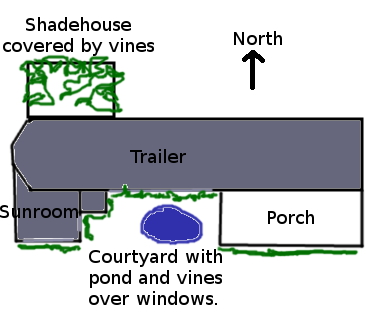 gain in the summer by 70%
and heat loss in the winter by 30% --- homegrown insulation!
Finally, a courtyard pond can buffer heat both during the summer
and the winter.
gain in the summer by 70%
and heat loss in the winter by 30% --- homegrown insulation!
Finally, a courtyard pond can buffer heat both during the summer
and the winter.
While I'm unlikely to
put all of these ideas into action right away (or maybe ever), I
couldn't help mocking up a design for the truly integrated
permaculture trailer. With the help of a few plants, we
might make our singlewide even more livable over time.
| This
post is part of our Mollison's
Introduction to Permaculture lunchtime series.
Read
all of the entries: |
We hauled some straw in with
the new
and improved bucket hauler
today.
Conditions are muddy, but it
seemed to handle the uneven driveway just fine.
Four bales might be the limit
for straw due to the load being top heavy.
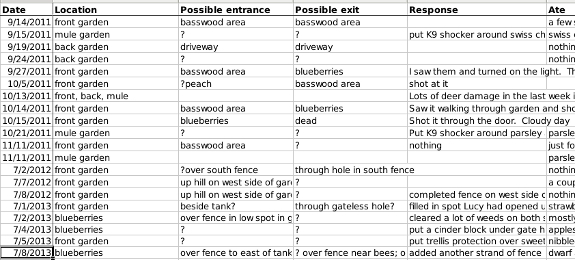
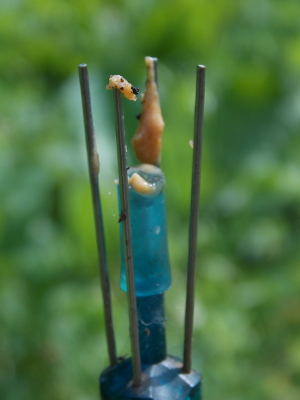 We take our war against the deer very
seriously, with multiple lines of defense, obsessive
data-gathering, and a complete
willingness to shoot on sight. And we seem to be winning. As you can
see from my spreadsheet above, there hadn't been a deer in the
garden for 12 months before the most recent raid, and before that
was an eight month gap. I'm hopeful our most recent work
will keep the deer out for at least another year, maybe longer.
We take our war against the deer very
seriously, with multiple lines of defense, obsessive
data-gathering, and a complete
willingness to shoot on sight. And we seem to be winning. As you can
see from my spreadsheet above, there hadn't been a deer in the
garden for 12 months before the most recent raid, and before that
was an eight month gap. I'm hopeful our most recent work
will keep the deer out for at least another year, maybe longer.
So what have we done
to improve the situation this time around? Mark mentioned clearing
tall weeds that shelter deer along the fencelines, putting
two of our mechanical deer deterrents back into action, adding
height to a troubled fence spot, and gating
in a gap we often walk through. We also put the wireless
deer fence
beside the most-nibbled spot and baited it with peanut
butter. I'm not sold on this little gadget actually doing
anything, but this is the kind of situation where it might come in
handy --- when a single deer is targeting one high-value spot.
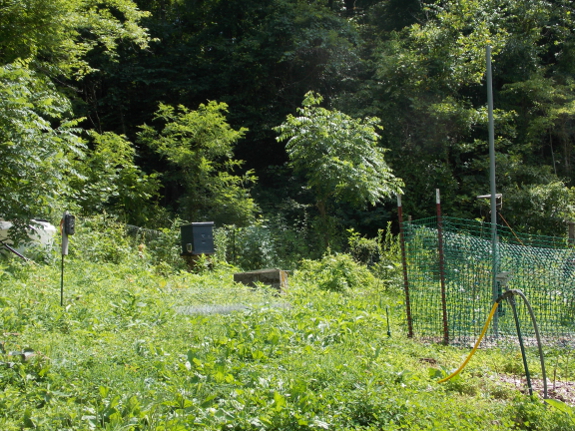
We didn't stop
there. We built a trellis barrier around the dwarf apples,
which seem to be one of the deer's favorite foods. Mark
hunted down the trail
camera and
installed it to start collecting more data, and I put more trellis
material over the strawberry and sweet potato beds that are
closest to the incursion spot.
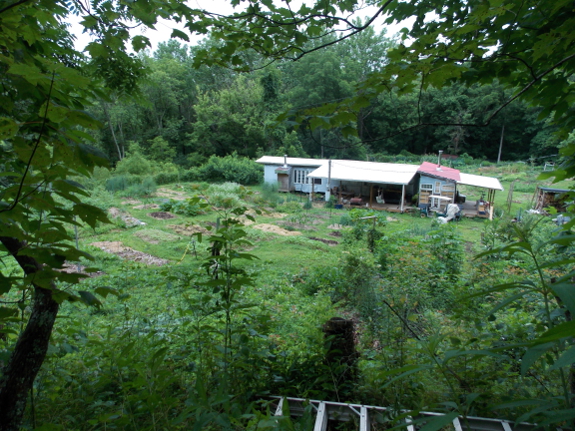
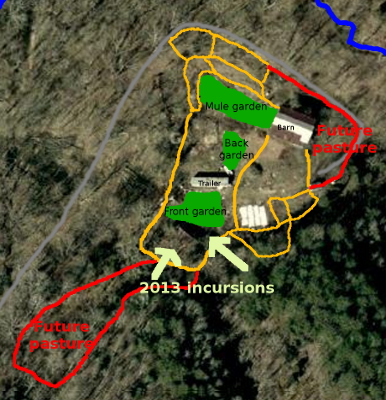 But those are really just stop-gap measures. Our
long-term goal is to moat the entire homestead,
since moats seem to be close to 100% effective at deterring deer,
even if the fences that make them up are only four or five feet
tall.
But those are really just stop-gap measures. Our
long-term goal is to moat the entire homestead,
since moats seem to be close to 100% effective at deterring deer,
even if the fences that make them up are only four or five feet
tall.
Actually, we've
already got most of the homestead moated if you count the
precipice at the edge of our plateau as a moat. (I
do.) I'd been considering leaving a deer path to let
wildlife walk between the pastures-to-be around the starplate
coop and our
blueberry patch so I'd still be able to shoot deer out the
living-room window, but now I'm thinking we'll hook those pastures
directly into our existing perimeter fence to moat that area
too. I'm not quite sure what we use we could put to a moat
above the well since we want to keep manure out of that area to
protect our drinking-water quality, but I'm sure we'll think of
something.

The new lawn
trailer bucket hauler had
its first horse manure run today.
My new method of stacking and strapping 7 buckets near the
cab brings the capacity to 28...add one bucket to the nearby worm bin
and then 3 trips with the bucket hauler and that equals a serious amount
of organic matter.
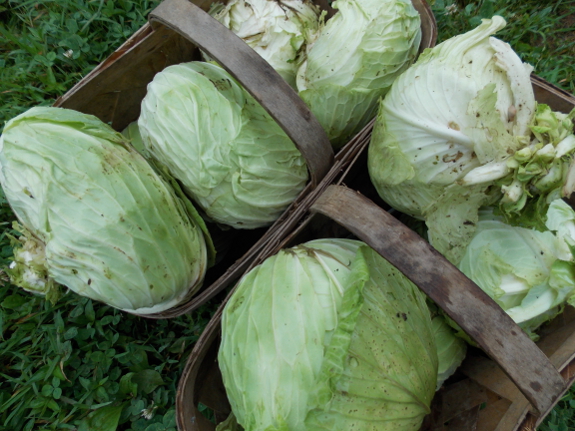
The tomatoes are late
this year and the cabbages are copious. The pair of events
is merged in my thinking because my primary use for spring
cabbages is as part of the stock for tomato-based
soups, meaning
that I want tomatoes and cabbages at the same time and in
proportion to each other. While we can definitely eat up
some of the cabbages without tomatoes, I don't want to run out of
cabbage during soup season. So this year I'm experimenting
with time-lapse soup.
What's time-lapse
soup? It's simple --- I process each ingredient when it's on
hand, freeze it, then thaw out various bits to compile into soup
later. For example, I had more chicken carcasses this winter
than I needed right away, so I made broth out of the bones and
froze that. Now I'm thawing the chicken broth and using it
with cabbages, potato onions, parsley, and the end of last year's
garlic to make a denser stock. When the tomatoes come in,
I'm thinking I'll just turn them into paste, then in the winter
I'll thaw containers of paste, stock, green beans, and sweet corn,
add in some carrots, and make my soup that way.
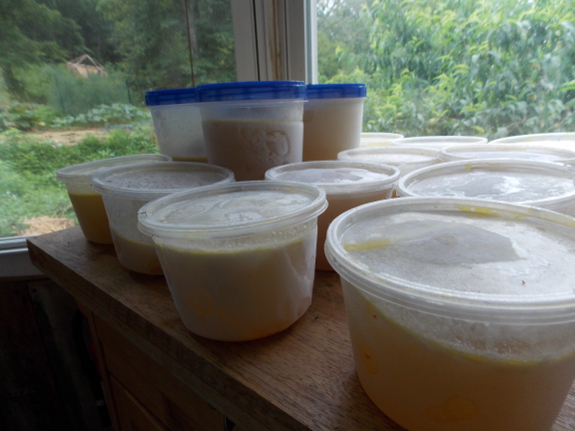
The biggest flaw in
this plan is that I froze the initial broth, thawed it, then froze
it again with vegetables added. I had assumed that
refreezing was forbidden, but the internet explained that the
trouble with refreezing is that the freezer doesn't kill germs,
just puts them on hold. So the germs can multiply during the
thawing process, sit in the refrozen food, then multiply again
during the second thaw, resulting in high microorganism
populations and food that's a bit dicey. Luckily, the
intermediate boiling step sets the clock back, so my refreezing
shouldn't be a problem.
The jury's still out
on whether the winter-compiled soup will taste as good as a soup
made all at once during the summer months. I guess we'll
have to wait and see....
These new heavy duty tie
downs were easy to install in a few minutes.
I was going to use an eye
bolt, but these looked better suited for ratchet straps.
You get a package of four for
5 dollars and they're rated at 400 pounds.
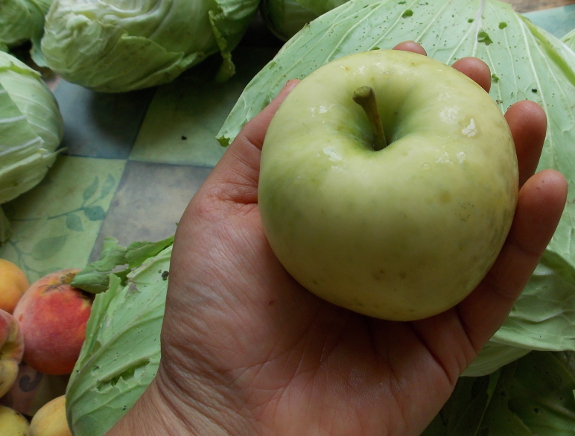
If you aren't buying
your apples from a store and are instead keeping them in a root
cellar, your storage apples are going to give out by February or
so, leaving you with a hankering for crisp pomes in early
summer. The first apples might ripen up as late as July (or
even August) if you live in New England (or have a particularly
cool, rainy year like this one), but around here they're often
called "June apples" and tend to come on in late June. June
apples have a less intense flavor than later apples and they tend
to keep only a few days once they're ripe, so you wouldn't want to
plan a whole orchard around them, but one or two trees in your
garden are a summer treat.
Yellow Transparent is
the standby June apple in our area, and we've got a dwarf in our high-density planting and a
semi-dwarf in the forest garden. Thursday, Mark and I tasted
the first ripe sample (from the high-density planting) and gave it
top marks. Yellow Transparent (also known as White
Transparent, Russian Transparent, and Grand Sultan) wouldn't stand
up against really flavorful fall apples, but it beats the kind you
get in the store at this time of year and makes an excellent sauce
and pie. The trick with Yellow Transparent is to wait until
the flesh turns very yellow-green, and then to pick the fruit
right away before it gets mealy.
Tim Hensley, the source of several of our apples, posted the embedded youtube video this week
to highlight four other early apples he recommends (along with the
Yellow Transparent, which is the most popular and largest).
Henry Clay (a very small, ribbed apple introduced by Starks Bros.)
won his taste test, although the Red Astrachan was also noted to
be richly flavored. Lodi is an offspring of Yellow
Transparent that is more resistant to fire blight, but Hensley
notes that most people prefer the taste and texture of the parent
apple. Finally, Early Harvest is the very earliest apple he
reviewed, with apples sometimes ripening as soon as June 1, and
being sweeter than the other early apples.
We may try another
early apple in our high density planting next year since it looks
like the Pristine (a new, hybrid early apple) can't take the fungi
in our climate. The trick will be determining which of these
early apples is as disease resistant as
the Early Transparent, which seems to thrive despite our cedar
apple rust and general dampness.
Is there a preferred early-apple variety in your neck of the
woods? When do the first apples near you ripen? I'd be
curious to hear if Yellow Transparent is a standby in other areas,
or just around here.
Our first silk
worm moth showed up this
week!
There will be no flight for
these wings due to generations of domestic breeding.
No food or drink either. The
only job this moth has to do is hope one of the other cocoons changes
into a moth and ask her out on a date.
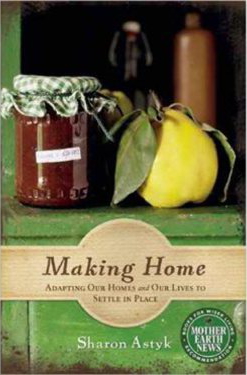 I reviewed Sharon Astyk's book Depletion
and Abundance a
couple of years ago, and since then I've fallen a bit out of love
with her blog. This often happens to me when a blogger
becomes repetitive, rehashing the same information over and over
--- it's interesting the first time, but not thereafter.
Still, I thought it was worth a shot to read her newest book, Making
Home.
I reviewed Sharon Astyk's book Depletion
and Abundance a
couple of years ago, and since then I've fallen a bit out of love
with her blog. This often happens to me when a blogger
becomes repetitive, rehashing the same information over and over
--- it's interesting the first time, but not thereafter.
Still, I thought it was worth a shot to read her newest book, Making
Home.
Astyk's thesis is
that Peak Oil will result in a very different world from the one
we now know. The book revolves around the idea of adapting
in place --- choosing a spot where you want to put down roots,
then making changes immediately so you won't be so hard hit when
the consequences of Peak Oil begin to be felt more widely.
As you might expect, the book gets a bit Doomy, especially in the
second half, but if you don't mind wading through that, you'll
find some handy information on emergency preparedness and
homesteading, especially from a social perspective.
On the other hand,
much of the information would be hard for us to put into
practice. Astyk is part of a relatively tightly-knit Jewish
community, and she and her husband have four kids plus an
ever-shifting number of foster kids. If you don't have a
faith-based community to fall back on, and don't have children,
you might as well skip about a third of the book and likely won't
find any community-building information that will appeal to you.
 On the other hand,
Astyk's housing advice is more spot-on from our Trailersteading perspective. When
she and her husband were house-hunting, Astyk considered moving
into an Amish-built house (with the lack of electricity and other
facilities that you'd expect). She felt (as I do) that it's
much easier to start with nothing and slowly built more
sustainable workarounds than to move into a modern American house
and try to go backward. Her husband rebelled against the
Amish house, but they both seem content with living in what Astyk
calls a "working home" instead of a "show home," one that produces
rather than consumes. "[American] standards of cleanliness
and perfection can be so high," she wrote, "precisely because
homes are expensive spaces in which we do not ordinarily live."
On the other hand,
Astyk's housing advice is more spot-on from our Trailersteading perspective. When
she and her husband were house-hunting, Astyk considered moving
into an Amish-built house (with the lack of electricity and other
facilities that you'd expect). She felt (as I do) that it's
much easier to start with nothing and slowly built more
sustainable workarounds than to move into a modern American house
and try to go backward. Her husband rebelled against the
Amish house, but they both seem content with living in what Astyk
calls a "working home" instead of a "show home," one that produces
rather than consumes. "[American] standards of cleanliness
and perfection can be so high," she wrote, "precisely because
homes are expensive spaces in which we do not ordinarily live."
Astyk's take on
finances was also interesting. Of course, she recommended
that you prioritize getting out of debt, hypothesizing that debt
will be harder to deal with in the future than it is now.
But what if you have money to invest
for retirement?
Astyk believes that gold and silver will actually lose value, and
she (not entirely tongue-in-cheek) recommends investing in
alcohol, prescription sedatives, porn, and escapist videos
instead. More seriously, she recommends that we try not to
look at money as the only means to an end, and to focus on the end
itself. What will we need in the future, and what can we
spend time or money on now to prepare for that?
In the end, I felt Making Home was a
thought-provoking read, but I was thrown off by the internetisms
that popped up (smileys in a print book?) and by the word-for-word
reprints of articles I'd already seen on her blog. I'm also
a bit leery of the whole premise of the book --- yes, I believe in
Peak Oil, but I don't really believe we can predict what the
future looks like, and I also don't like the idea of planning your
life out of fear. Why not focus on being more sustainable
and self-sufficient for the joys it brings now, rather than
because it may or may not make your future easier than your
neighbors'? Despite my complaints, though, the book is well
worth a read, and is light enough to make fast summer reading.
We recently upgraded our TC1840H
garden wagon with a Sandusky utility wagon.
It's a little heavier duty
but about the same size. Cost was just under 150 with shipping.
Some of the reviews talk
about it being too heavy to pull, but it seems fine to us. Our helper
Dillon had no problem pulling it by himself loaded with firewood on Friday.
 A little over a year ago, I
posted about my brother Joey's Kickstarter project to fund his free
software development project. I explained that, even though
git-annex isn't all that homesteading related, Joey's hard work in
the free software community is what keeps the backend of this blog
afloat.
A little over a year ago, I
posted about my brother Joey's Kickstarter project to fund his free
software development project. I explained that, even though
git-annex isn't all that homesteading related, Joey's hard work in
the free software community is what keeps the backend of this blog
afloat.
Completely unrelated
to my blog post, Joey's Kickstarter was funded in the first day,
and he went on to rake in enough cash to pay his (very basic)
living expenses for a full year of coding. Everyone who
donated got their money's worth and much more. My only
complaint is that Joey hasn't been over to visit nearly enough in
the last year because he's been burning the midnight oil coding,
paying himself roughly minimum wage from the Kickstarter
funds. And the results have been helping scores of people,
like Joe who wrote in to say:
At long last, the
Kickstarter money ran out, but Joey's project keeps attracting new
users with new needs. So he's
launching a second-generation campaign, with the tiny goal of
$3,000 to fund three more months of coding. If all of Walden
Effect's loyal readers donate at the virtual hug level (a mere
$5), we could fund Joey for a year and a half. What do you
say we help him reach his goal in less than 24 hours again?
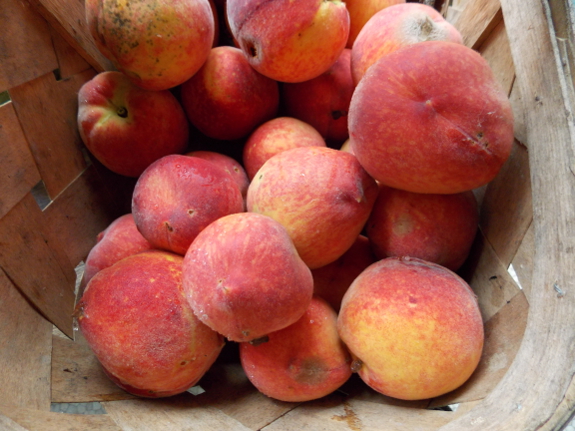
A week ago, I
posted about how this abnormally-wet summer has turned our peach
trees into a breeding ground for brown rot, and why
I don't want to use a fungicide to combat the infection. I decided to try
two different methods of getting edible peaches despite the rot
--- picking some when they were ripe enough to finish ripening
inside, and leaving others on the tree but plucking off any fruits
that came down with the disease.
The second method was
a big loser --- the tree-ripened fruits tended to start rotting
when they were still apple-hard, and my secondary experiment of
cutting out the bad spots and letting the peaches ripen in the
fridge was a total failure. On the other hand, plucking
beautiful peaches off the tree and ripening them inside worked
well, producing fruits at least as tasty as the best I've found at
roadside stands and produce patches. So, this week, I'm
taking a preemptive approach and picking all of the peaches that
are old enough to ripen inside right away.
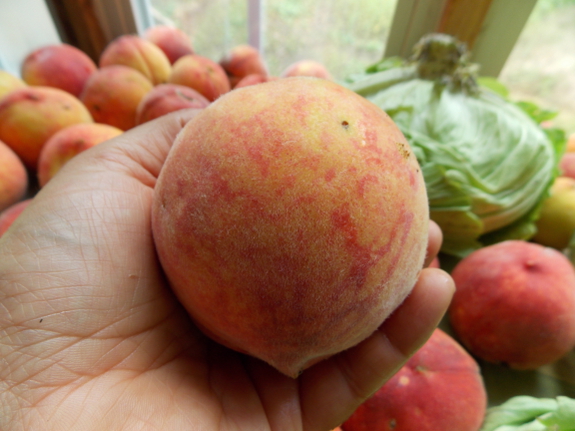
How can you tell if a
peach has ripened enough on the tree to produce luscious fruit
inside? The trick is to ignore the red color (which tells
you how much sun the peach got, not how ripe it is) and to focus
on the yellowish ground color. If the ground color is
yellow-orange, your peach is ready...
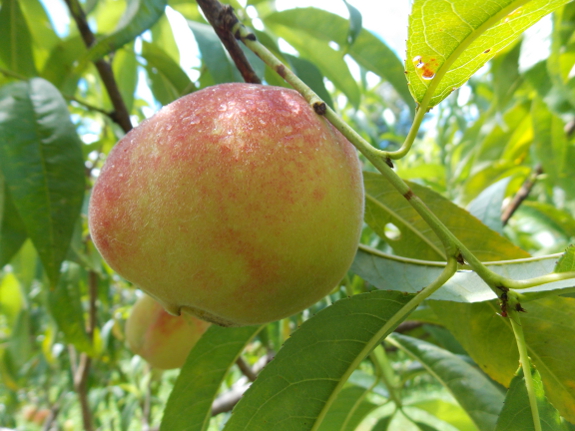
...but if the ground
is a yellow-green, the fruit needs more days on the tree.
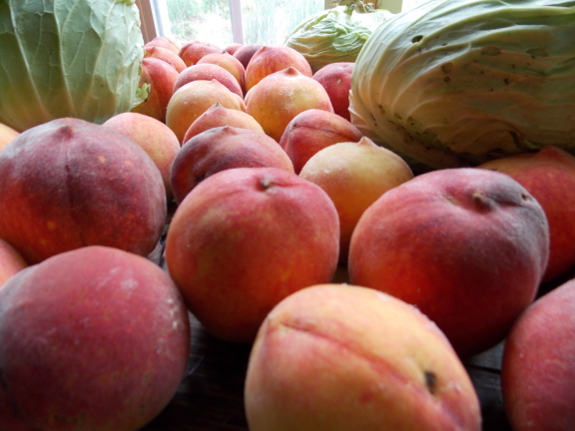
The internet suggests
several different ways to ripen peaches inside, ranging from paper
bags to cloth coverings. I've actually had good luck just
setting them on a counter or in a fruit basket. (You can see
that not all of my cabbages have yet made their way into time-lapse
soup.)
Using this method, I suspect we'll end up with a pretty good crop
of peaches this year, despite the rain.
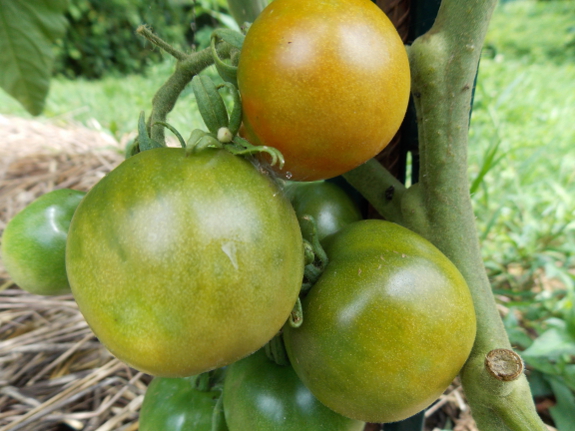
In the meantime,
summer does appear to be arriving at long last. The first
tomato started blushing Saturday, and the dog-day cicadas are
finally making a spotty start on their mating calls. We
enjoyed two or three rainless days last week, and hope for even
more this week. Wish us sun!
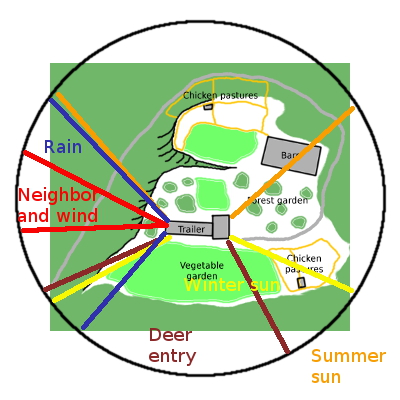 Despite getting carried away and finishing
up Mollison's book before moving on with Will
Hooker's video course, I didn't completely give up on the latter. Over
the last few weeks, I've worked my way through lectures 6, 7, and
8, along with the corresponding reading material about
permaculture as a design process, about patterns, and about
starting a vegetable garden.
Despite getting carried away and finishing
up Mollison's book before moving on with Will
Hooker's video course, I didn't completely give up on the latter. Over
the last few weeks, I've worked my way through lectures 6, 7, and
8, along with the corresponding reading material about
permaculture as a design process, about patterns, and about
starting a vegetable garden.
All three lectures
were pretty basic, and lecture 7, especially didn't contain much
of value. (I felt Will Hooker got a bit caught up in what I
consider New Age math.) On the other hand, gems jumped out
at me from the other two videos.
In addition to the
sun angle information that I'm going to devote a later post to, my
favorite part of lecture 6 was the notion of beginning the design
process with a sector analysis. The image at the top of this
post charts where forces of nature (and other elements beyond our
control) enter the farm. Although we already know our farm
well enough that we didn't receive any new information from the
sector analysis, those of you new an area might use the
information in a sector analysis to conclude you shouldn't plant
your fruit trees where they'll block the winter sun, that you should plant a dense barrier
where the wind comes gusting in off the prairie, and that you
might consider either making an edible garden where the neighbor's
children encroach, or keeping them out with thorny bushes
(depending on how you feel about the kids in question).
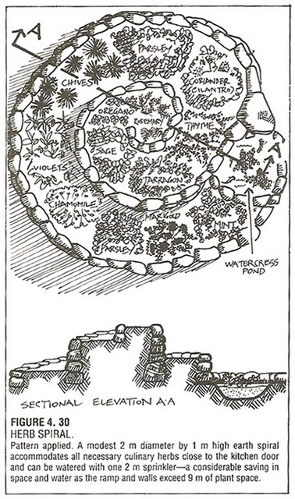 Shifting gears, Lecture 8
contained a good introduction to permaculture gardening techniques
--- I recommend that video for beginners. I enjoyed Hooker's
reiteration of the admonition to start gardening wherever you are,
even if you're renting; your first garden will be far from
perfect, so you might as well begin the trial and error process
now rather than putting it off until you have the perfect
plot. He also scavenges
biomass just
like I do, and has an excellent piece of advice there --- steer
clear of bags of clippings and leaves from beautiful lawns, since
those are more likely to be dosed in herbicides.
Shifting gears, Lecture 8
contained a good introduction to permaculture gardening techniques
--- I recommend that video for beginners. I enjoyed Hooker's
reiteration of the admonition to start gardening wherever you are,
even if you're renting; your first garden will be far from
perfect, so you might as well begin the trial and error process
now rather than putting it off until you have the perfect
plot. He also scavenges
biomass just
like I do, and has an excellent piece of advice there --- steer
clear of bags of clippings and leaves from beautiful lawns, since
those are more likely to be dosed in herbicides.
As usual, I had mixed
feelings about the reading in Gaia's Garden. Even though I tried out
keyhole beds when I was new to permaculture, I believe both keyhole
beds and herb spirals are trendy techniques that create much
more work than old-school straight lines and rectangles. On
the other hand, I do like the concept of designing from patterns
to details, looking at the flows and patterns already present in
your landscape, and optimizing them. For example, Hemenway
explains that a tree's branch design is a useful pattern to mimic
in drip irrigation systems, and that people tend to flow like
water.
I've got a bit more
to say about this trio of lectures in later posts, but for now,
here's the reading material for the next set of lectures:
- Chapters 2 and 4 in Building
Soils for Better Crops. (Free download.)
- NRCS
Soil Biology Primer. (Read for free online.)
- Cornell
Soil Health Assessment Manual. (Free download.)
- Gaia's
Garden chapter 4 (soil)
- Introduction to Permaculture chapter 5 (home garden)
If you've been
watching along with me, I'd be curious to hear if different parts
of these lectures caught your interest than caught mine.
The worst part of our
driveway is a section that turns and one of the ruts is deeper than the
other creating a situation where it causes the trailer to almost tip
over.
Until I fix that part of the
driveway the bucket hauler trailer limit for straw bales will be
3...with a couple of bales bungee strapped to the ATV.
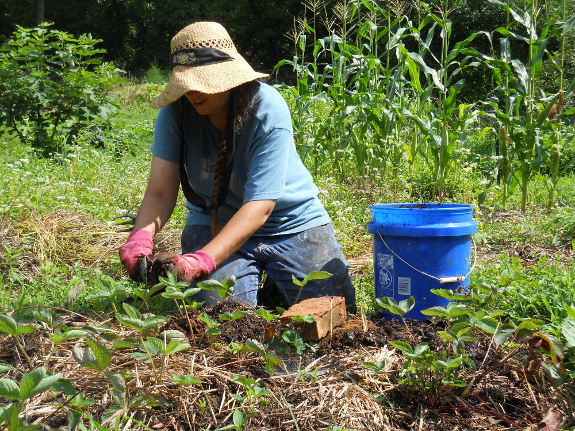
Some of the herbicides in the aminopyralid group can be long lasting and can survive the transit thru a horses GI tract. They're great for managing a horse pasture because they are long-lasting, but the resulting manure is supposed to be kept out of the compost heap, as the warning on the containers states. Some compost sold to gardeners has been know to contain these chemicals. I'd like to think they made it there inadvertently rather than thru motives of greed.
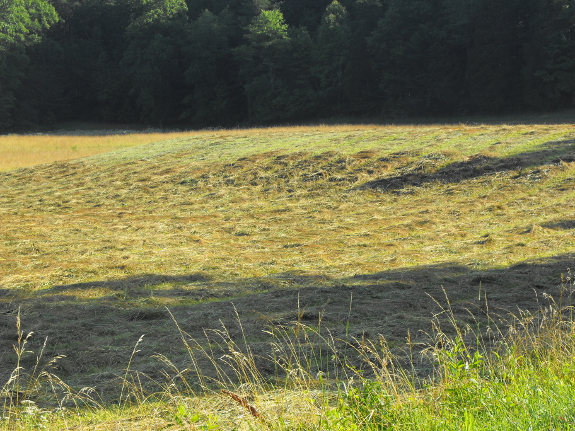
That's an excellent
question, and the answer will depend on how livestock are
kept near you. In our area, hay is a very low-impact crop
--- people simply let whatever's there grow up, mow it once,
twice, or thrice a year, and that's that. They do sometimes
spread chemical fertilizers on the ground to make up for the
nutrients they take away while haying, but I'm willing to put up
with the possible lack of micronutrients that might result once
the hay passes through a horse and ends up in my garden. I'd
be much more leery of the hay if it was raised in a different
manner, but I don't expect people in our economically depressed
region to have enough funding to improve their hayfields by
plowing and replanting any time soon.
While herbicide use on the pasture is slightly more likely in our
area, it also seems to be far from widespread. Most of the
surrounding pastures are what's known as "unimproved," meaning
that they're produced by mowing whatever's there repeatedly until
only grasses and low weeds remain. If our manure-producers
were using herbicides on their pastures, we'd likely know right
away since our crops would fail, then we'd find another source of
manure.

The larger problem
with horse manure is pharmaceuticals that might have been fed to
the horses, specifically dewormers. A couple of years ago,
there were a spate of articles about home gardeners who lost crops
due to using compost that was based on horse manure with dewormers
in it. This is always a gamble, although the longer you age
the manure between horse and garden, the lower your risk is.
I've never seen any issues in our own garden, so I suspect if the
relevant horse owners use dewormers, their use is minimal enough
that the chemicals break down quickly in our biologically-rich
soil.
Although not a
chemical issue, everyone will have to deal with the problem of
weed seeds in their horse manure. In a perfect world, we'd
compost the manure well enough to kill the seeds, but in this real
world, I just hand-pull and mulch, which deals with any weeds that
might otherwise pop up.
In the end, I'm not
an organic purist from a labeling standpoint --- I'm sure the
horse manure we use wouldn't fly if we wanted to jump through the
hoops to sell our produce as organic. We're more interested
in our own health and the quality of our soil than in the word
"organic," though, and the horse manure we use seems to be the
best option there, given our location.
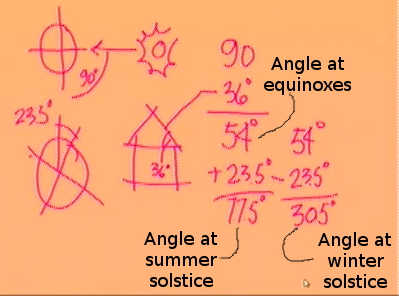 One of the reasons I'm plugging along with Will
Hooker's permaculture videos even though I know most of the
information is that I want to fill in any obvious gaps in my
scattered, homeschooled education. So I was thrilled to have
sun angles finally explained to me in a manner I could understand
in lecture 6.
One of the reasons I'm plugging along with Will
Hooker's permaculture videos even though I know most of the
information is that I want to fill in any obvious gaps in my
scattered, homeschooled education. So I was thrilled to have
sun angles finally explained to me in a manner I could understand
in lecture 6.
I've posted
previously about the
science behind sun angles, but the math has always eluded me. Luckily,
Hooker broke it down into simple arithmetic. All you have to
do to find the height of the sun above the horizon at the
equinoxes is to subtract your latitude from 90 degrees --- so, the
equinox sun is 54 degrees above the horizon at a latitude of 36
degrees. Since the sun angle at the equinox splits the
difference between summer and winter sun angles, people often use
this figure to calculate the tilt of their solar panels. If
you want to have the sun's rays striking a solar panel
perpendicularly at the equinox, just tilt the panel the same
number of degrees as your latitude --- 36.8 degrees here. If
you want a bit more efficiency from your panels in the winter,
tilt the panel a bit steeper; for a bit more energy in the summer,
tilt the panel more shallowly.
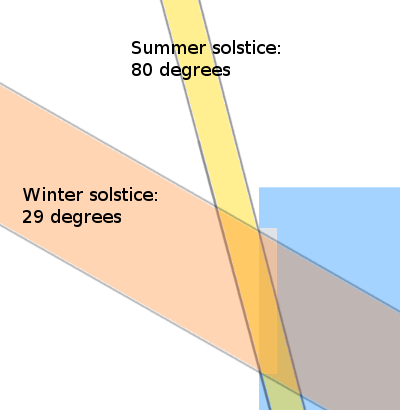 In order to figure out the sun angle at the
summer and winter solstice, you need to understand that the earth
is tilted at an angle of 23.5 degrees. (This is what gives
us seasons.) At the summer solstice, you add the earth's
tilt to the equinox's angle --- so Will Hooker's sun angle at the
summer solstice is 77.5 degrees (and ours is 76.7). At the
winter solstice, you subtract the tilt of the earth, so for us the
sun angle at the winter solstice is 29.7 degrees. These two
sun angles are what you need to determine
overhang depths for passive-solar structures.
In order to figure out the sun angle at the
summer and winter solstice, you need to understand that the earth
is tilted at an angle of 23.5 degrees. (This is what gives
us seasons.) At the summer solstice, you add the earth's
tilt to the equinox's angle --- so Will Hooker's sun angle at the
summer solstice is 77.5 degrees (and ours is 76.7). At the
winter solstice, you subtract the tilt of the earth, so for us the
sun angle at the winter solstice is 29.7 degrees. These two
sun angles are what you need to determine
overhang depths for passive-solar structures.
This information is just what we needed as we plan
more energy-saving trailer retrofits!
This drill powered
plucker is still our preferred tool for getting feathers off
chickens.
We retired 6 chickens today
which equals about a half hour of time saved according to last year's
estimations.
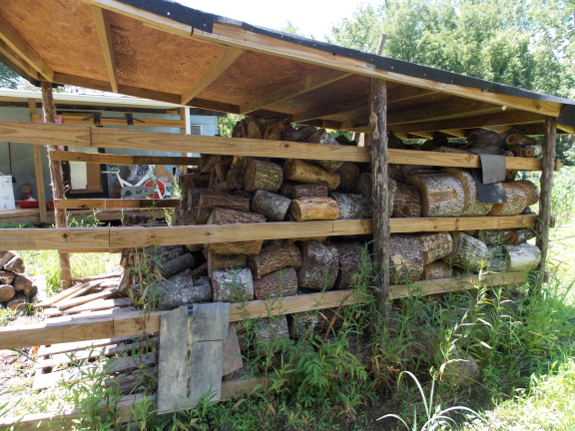
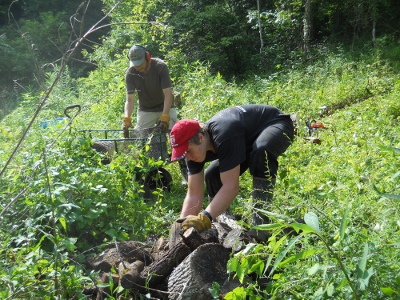 My goal is always to get all of our firewood
into the shed to dry by early June...but that's never
happened. This year, the new
pasture project
resulted in enough firewood for the winter, but we were too busy
to move most of that wood to the shed in a timely manner.
Luckily, Dillon was kind enough to come
lug firewood for two mornings and get it all under cover.
My goal is always to get all of our firewood
into the shed to dry by early June...but that's never
happened. This year, the new
pasture project
resulted in enough firewood for the winter, but we were too busy
to move most of that wood to the shed in a timely manner.
Luckily, Dillon was kind enough to come
lug firewood for two mornings and get it all under cover.
Last year, I stacked
the shed a little differently. I separated out the harder
woods to one side 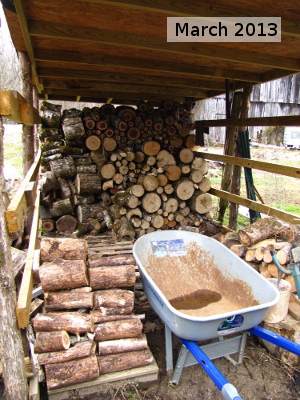 and the softer, kindling-woods to the other,
which made it easy to manage my burns. But that meant I had
to leave an aisle down the middle, which took up a lot of
space. Since we have a vast array of different kinds of wood
this year, I let Dillon stack it all together, with the result
that I think we currently have as much wood in the shed as last
year, but have room for more if we track some down.
and the softer, kindling-woods to the other,
which made it easy to manage my burns. But that meant I had
to leave an aisle down the middle, which took up a lot of
space. Since we have a vast array of different kinds of wood
this year, I let Dillon stack it all together, with the result
that I think we currently have as much wood in the shed as last
year, but have room for more if we track some down.
Burning prolifically
like I did last winter, I figure one row of wood will last through
a warm month (like November or March), while the cold months take
up two rows of wood. It looks like we've got a bit of extra
wiggle room already, so maybe we won't run
out in March.
As I've typed before, every year gets a little better here on the
farm!
One of the assignments
associated with Will
Hooker's permaculture course is to watch The
End of Suburbia,
a documentary assessing the future of American suburbs post Peak
Oil. Since Sharon Astyk's Making Home covered the same
hypothetical (but with different imagined results), I thought it
would be interesting for me to sum up the differences between each
philosopher's take on the issue.
James Howard Kunstler
(and other speakers) spend the majority of the video explaining
how suburbs came about. I won't rehash all of this
information, but the major factors leading to the rise of suburbia
seem to have been the ubiquity of the automobile, cheap oil
allowing us to drive everywhere we want to go, and a
post-World-War-II push for non-urban housing. Kunstler
suspects that transportation will become much more expensive in
the future, making suburbs unsustainable as they're currently laid
out. His solution is to relocalize our suburbs so basic
needs can be met within walking distance --- otherwise, he sees
the suburban experiment failing.
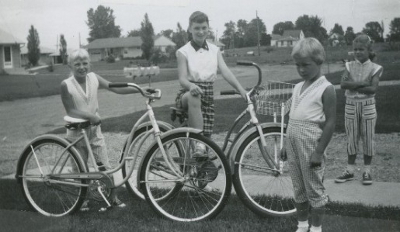 Sharon Astyk considered
the issue more broadly by looking at the impact of Peak Oil on the
three places you can live (cities, suburbia, and farms). She
believes that each area has a future, but that the future is
different for each one (and, in each, is different from the way we
live now).
Sharon Astyk considered
the issue more broadly by looking at the impact of Peak Oil on the
three places you can live (cities, suburbia, and farms). She
believes that each area has a future, but that the future is
different for each one (and, in each, is different from the way we
live now).
Astyk wrote that
rural areas will suffer in many of the ways they already do, only
more so. Jobs will become even scarcer, and transportation
costs will make it increasingly difficult to get from place to
place. People who currently live in bedroom communities
(enjoying the peace and quiet of the countryside while commuting
into jobs in the city) will have to make a choice between the
rural and urban life, and will likely choose the latter. The
resulting lower tax base will force rural governments to make
tough decisions about what to pay for --- schools or snowplows?
--- so those of us remaining behind will need to fend for
ourselves. On the plus side, ungentrification will result in
lower land prices, meaning that people may be able to afford
better housing (or at least to scavenge building materials from
abandoned McMansions), while people with subsistence skills will
be able to take advantage of the open space to grow or hunt their
food.
 Astyk thinks cities
of the future will have lower populations, but many people will be
able to maintain an urban life if they're able to change rapidly
from business to business to fill shifting niches.
Close-knit communities are one of the characteristics Astyk thinks
all post-peak-oil people will need to focus on, but this will be
even more true in the cities. There won't be as much
deterioration of public infrastructure as in the country, but when
power outages and other events occur, the results will be more
severe in urban areas. Astyk recommends making your home in
an urban area only if you think you could live in the worst part
of town as it is now; in essence, she envisions the future there
being much like life currently is for the urban poor.
Astyk thinks cities
of the future will have lower populations, but many people will be
able to maintain an urban life if they're able to change rapidly
from business to business to fill shifting niches.
Close-knit communities are one of the characteristics Astyk thinks
all post-peak-oil people will need to focus on, but this will be
even more true in the cities. There won't be as much
deterioration of public infrastructure as in the country, but when
power outages and other events occur, the results will be more
severe in urban areas. Astyk recommends making your home in
an urban area only if you think you could live in the worst part
of town as it is now; in essence, she envisions the future there
being much like life currently is for the urban poor.
Astyk believes some
suburbs will survive Peak Oil, but those that do will become
similar to nineteenth-century towns, able to meet most of their
needs by containing farmland interspersed with homes and
businesses. The problems and opportunities offered by
post-Peak-Oil suburbia will be a halfway house between urban and
rural areas, with suburban inhabitants also taking a dual approach
of becoming partly self-sufficient while also taking part in the
larger economy, at least part-time. Success in suburbia will
depend on maintaining a small income while minimizing expenses,
and Astyk suspects that will involve extended family groups living
together in consolidated housing.
As with Sharon
Astyk's book, I feel like this type of philosophizing has limited
utility (although it can be a fun thought problem). On the
other hand, envisioning a post-Peak-Oil future can lead into the
always-interesting discussion of which type of home is more
sustainable right now, a farmhouse, a city apartment, or a
McMansion in suburbia. What do you think?
Our first silk moth showed up a few days too early
and had nobody to mate with.
Turns out the dating window
is only 2 or 3 days.
Luckily the next party was a
bit more livelier with at least one female coupling with one of the
males...and then one of the other males. Not long after that came the
egg laying.
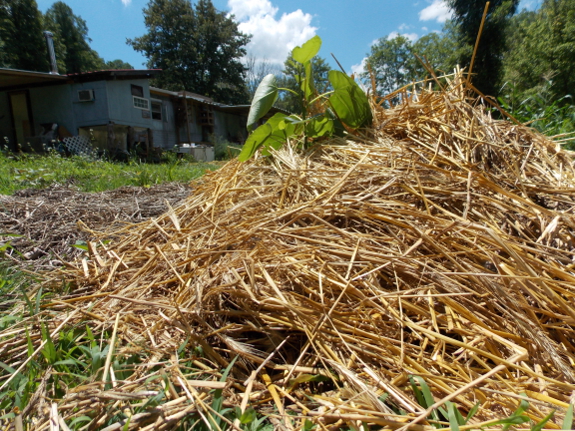
This wet summer has
proven to me that tree
mounds are even
more essential than I'd thought in the high-groundwater area of
the forest garden. We have five baby
figs ready to
go in the ground...or, rather, above it...so I've been figuring
out the easiest way to produce good soil that will stay high and
dry.
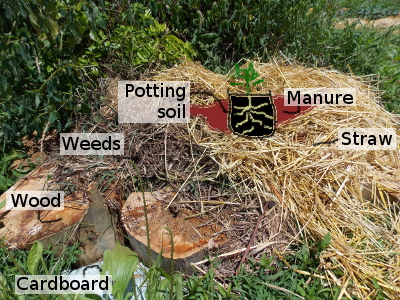 My current method is a modified
kill-mulch/hugelkultur mound. I lay down a sheet of
cardboard as a weed barrier, layer on three or four
wheelbarrow-loads of weeds from the garden, and toss in any punky
firewood I find lying around. In a year or so, I could plant
into that as-is, but since I want to plant sooner, I make a
depression in the middle, pour a baby tree out of its pot with all
of the soil intact around its root ball, then add a bucket of
horse manure around the edges of the potting soil. I top it
all off with a straw mulch, and I'm done...for now.
My current method is a modified
kill-mulch/hugelkultur mound. I lay down a sheet of
cardboard as a weed barrier, layer on three or four
wheelbarrow-loads of weeds from the garden, and toss in any punky
firewood I find lying around. In a year or so, I could plant
into that as-is, but since I want to plant sooner, I make a
depression in the middle, pour a baby tree out of its pot with all
of the soil intact around its root ball, then add a bucket of
horse manure around the edges of the potting soil. I top it
all off with a straw mulch, and I'm done...for now.
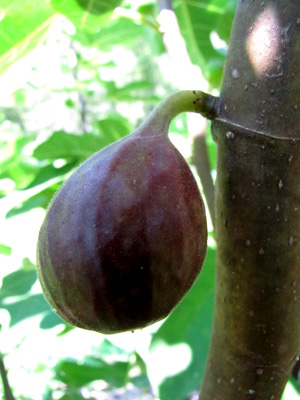 The trees will be
able to grow into the partially-composted manure nearly right
away, and will reach the woodier organic matter around the time it
starts to decompose. I suspect the weeds will rot down to
become just an inch or two of humus, but hopefully the addition of
punky wood will keep figs out of the groundwater longer.
I'll continue adding either hugelkultur
or weed donuts
around the plants, though, to give the plants dryish ground to
grow into over the years.
The trees will be
able to grow into the partially-composted manure nearly right
away, and will reach the woodier organic matter around the time it
starts to decompose. I suspect the weeds will rot down to
become just an inch or two of humus, but hopefully the addition of
punky wood will keep figs out of the groundwater longer.
I'll continue adding either hugelkultur
or weed donuts
around the plants, though, to give the plants dryish ground to
grow into over the years.
Last year, figs
proved themselves to be one of our easiest and most productive
fruit trees, so it's good to have some new varieties join the
club. I'll let you know if Black Mission and Dwarf can
survive our winters with
protection like
Chicago Hardy and Celeste did. Stay tuned for details next
spring (and for ripe figs in a month or so --- the photo above is
from last August).
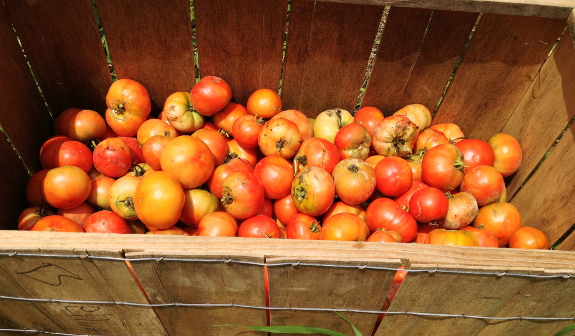
Having the earliest tomato in my family comes with some pretty big bragging rights, because not only are tomatoes the trophy crop of the garden, but as Anna wrote here, they are necessary for a lot of preserving tasks to come together. Luckily, our farm has been harvesting vine-ripened heirloom tomatoes for 4 weeks now at about 50-60 lbs a week. So, today I want to share my experiences in my quest for the earliest tomato.
The first thing you need to determine is the variety of tomato you wish to use. It is no secret that early tomatoes are typically lacking in flavor, and leave a lot to be desired. So far in my search I have amassed a collection of over 200 varieties that I maintain seed for, and the absolute worse I have tasted is ‘Early Girl’. My notes from a tasting in 2009 (my last year growing it) say this:
“Absolutely no acidity. Overly sweet, reminiscent of refined sugar. Watered down flavor that lacks in all regards. Poor texture, mealy...no better than a grocery tomato.”
My very favorite early variety has been ‘Sasha Altai’, a determinate tomato from Siberia, that is listed as 55 DTM (days to maturity), but came in on day 47 this year. When you first bite into it, the acidity fills your mouth, and as you begin to chew the flesh releases an earthy, satisfying sweetness. It is balanced by a very pleasant texture, and plenty of flavorful juice. Adding salt brings out the sweetness, and really rounds everything out nicely. It is almost as good as many of my late season heirlooms.
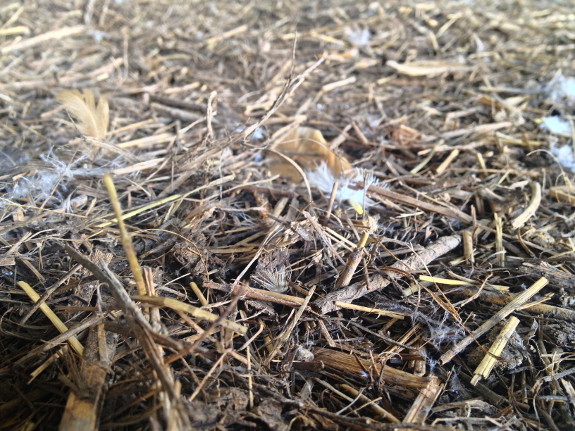
The next important thing is your soil. Early tomatoes go through most of the fruiting period during heavy rains, which can quickly leach out nutrients from your soil resulting in cracks, cat facing, and blossom end rot. This is primarily from a lack of calcium and magnesium, which are necessary for strong cell walls that will resist the swelling from excess water uptake. I always recommend composted poultry litter for solanaceous crops as the feathers and such really provide some good levels of Ca and Mg. Average poultry litter has an N-P-K of 3-3-2, and about 2% calcium and .5% magnesium.
The biggest (and easiest) mistake to make is thinking that an early planting will result in earlier tomato harvests, when in fact it can really set you back. Rather than planting by your last frost date, try to wait until the soil is as close to 70 degrees as possible. This year I transplanted mine outdoors at the end of April when the soil was 67 degrees. Nighttime air temps should not drop below 45-50 degrees.
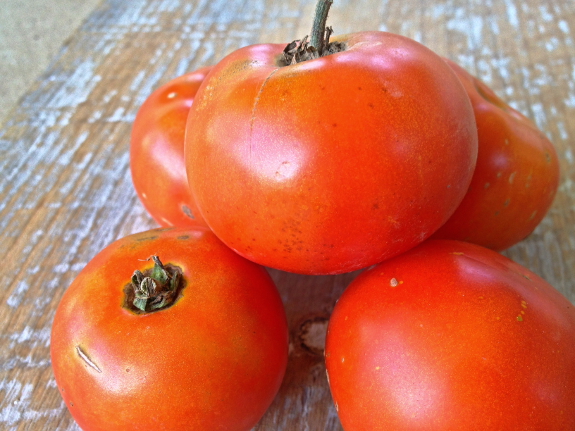
Tips & Tricks
-
Determinate varieties set and ripen in cooler weather.
-
Plant when soil is at least above 55 degrees, and air temps at night no lower than 45 degrees.
-
When planting, bury at least half of the tomato plant.
-
Prune suckers from plants at least once when about a foot tall.
-
Cut the bottom branches off once well established to help prevent fungal infections.
-
Make sure plants get early morning sunlight to dry the leaves as quickly as possible.
-
Amend soil with chicken litter or other high quality compost.
-
Save seeds from the earliest ripe tomato to plant next year. Continue this indefinitely.
 Whether you have 2,000 tomato plants like us, or just 2, these tips
should really help push your harvest a little earlier.
Anyone have a favorite variety to share? Maybe a helpful
trick? Feel free to share with everyone in the comments!
Whether you have 2,000 tomato plants like us, or just 2, these tips
should really help push your harvest a little earlier.
Anyone have a favorite variety to share? Maybe a helpful
trick? Feel free to share with everyone in the comments!
The golf
cart is in a better place now.
I finally got around to
towing it out of our way to a spot near the barn today.
It might need to be re-built
in the future if gas prices become too high or I might cannibalize parts
off it to build a 10 foot tall robotic rooster to scare away deer.
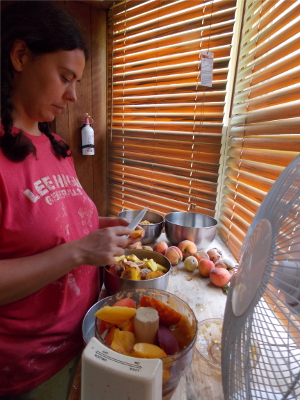 Sudden summer temperatures (high in the mid
nineties) made the
peaches I picked on Monday ripen up fast. They turned out to be the most
delectable peaches I've ever eaten, and I spent hours with sticky
juices rolling down my chin. At long last, though, I admitted
that we couldn't consume every one --- time to process the bounty.
Sudden summer temperatures (high in the mid
nineties) made the
peaches I picked on Monday ripen up fast. They turned out to be the most
delectable peaches I've ever eaten, and I spent hours with sticky
juices rolling down my chin. At long last, though, I admitted
that we couldn't consume every one --- time to process the bounty.
Earlier in the week,
I had figured out the best thing to do with peaches that develop a
rotten spot while still too hard to gnaw on. I cut off the
good flesh and cooked it up in water over gentle heat, producing
the most richly-flavored peach sauce ever. It turns out that
those peaches were plenty ripe to eat without additional
sweetening --- it was just the rock-hard flesh that was turning us
away.
With ripe peaches,
though, we prefer the flavor of uncooked fruit, so I made fruit
leather. Previously, I've skinned our peaches during
the preparation stage, but that doesn't seem to be necessary,
although it's (obviously) essential to hack away any rotten bits
and to remove the maggots in the center of two-thirds of our
peaches. (No, chickens
under the trees didn't seem to lower our Oriental fruit moth
pressure this spring. If anything, the tree our chicks
spent the most time under had the most moths.)
Despite ripening our
peaches inside, perhaps 10% of them still came down with brown
rot before they softened, so I experimented with adding the
good parts of these unripe peaches into the leather mix.
Although the result is a little chunkier than when using ripe
peaches, at a ratio of about 20% unripe flesh to 80% ripe flesh,
the resulting leather is even tastier than without. (I
understand this is how people make peach jam too, by including a
certain percent of unripe fruit.)
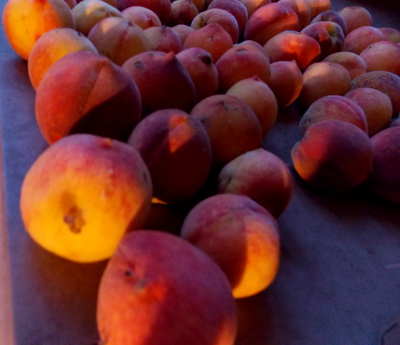 All of the peaches that were ripe by
Wednesday afternoon filled up the dehydrator to capacity, but more
were ready to go Thursday, and yet more will ripen over the
weekend. I'm carefully managing my peach stores, segregating
each day's pickings in one zone on the table so they're easy to
tell apart from their cohorts, then plucking out fruits that
develop the least sign of rot. Oh, and breathing in the
astonishing scent of a bushel of ripening peaches.
Delectable!
All of the peaches that were ripe by
Wednesday afternoon filled up the dehydrator to capacity, but more
were ready to go Thursday, and yet more will ripen over the
weekend. I'm carefully managing my peach stores, segregating
each day's pickings in one zone on the table so they're easy to
tell apart from their cohorts, then plucking out fruits that
develop the least sign of rot. Oh, and breathing in the
astonishing scent of a bushel of ripening peaches.
Delectable!
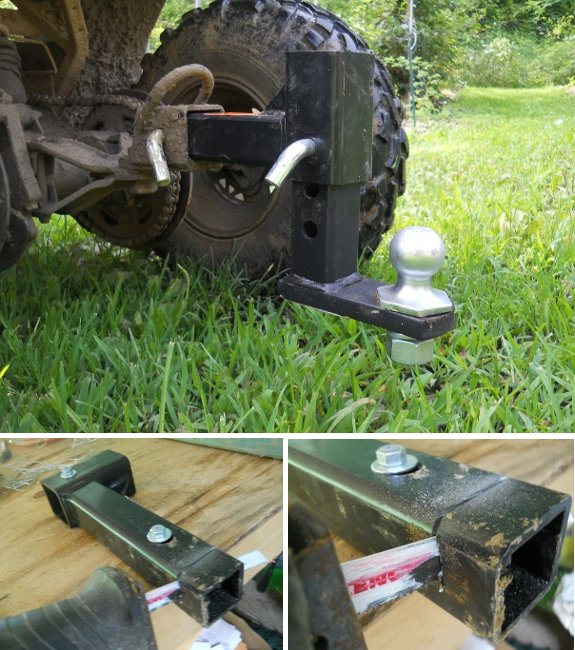
I ended up getting an
adjustable ball mount for the Kolpin ATV hitch
receiver so the new bucket hauler
lawn wagon could ride on
a more even keel.
It was too long to fit, but
once I mounted it to the top of our work bench it only took a minute to
saw what I think is the thickest metal I've ever cut through.
The height of the trailer
still tilts back a little, but it's a huge improvement.
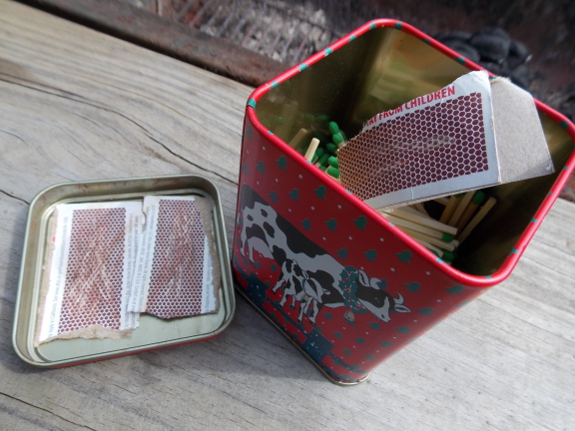
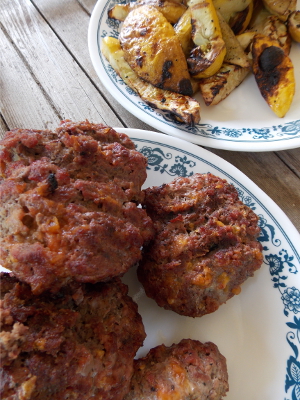 If you're looking for a very cheap-to-make present for the
homesteader on your list, you could do much worse than to follow
my mother's lead. She found a pretty tin (probably about
fifty cents at Goodwill), filled it with a box of matches (maybe
$4), then taped the striking papers to the inside of the
lid.
If you're looking for a very cheap-to-make present for the
homesteader on your list, you could do much worse than to follow
my mother's lead. She found a pretty tin (probably about
fifty cents at Goodwill), filled it with a box of matches (maybe
$4), then taped the striking papers to the inside of the
lid.
Despite the low cost,
this has been my favorite present in a long time. I used my
tin of matches to light all of our fires last winter, and this
summer pulled it out for a barbecue. I can't say for
sure which is more sustainable --- matches or a lighter --- but
matches produce no non-burnable waste, and keep my fingers further
from the flames, which keeps me happy. The metal container
keeps the matches dry even if I accidentally leave them on the
porch after a cookout, looks pretty, and also makes it safe to
store the matches right by the kindling wood.
Thanks for the great
present, Mom! For everyone else --- what's your favorite,
low-cost, homemade present that you've received recently?
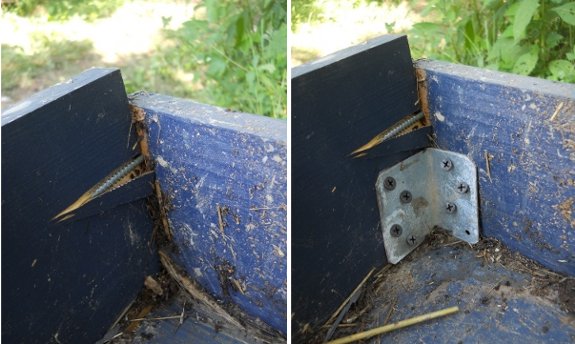
The new modified Haul Master lawn trailer I've been calling the Bucket Hauler is holding up nicely to some
serious muddy conditions.
One of the corners started
busting loose, but I think the above bracket will hold it in place.
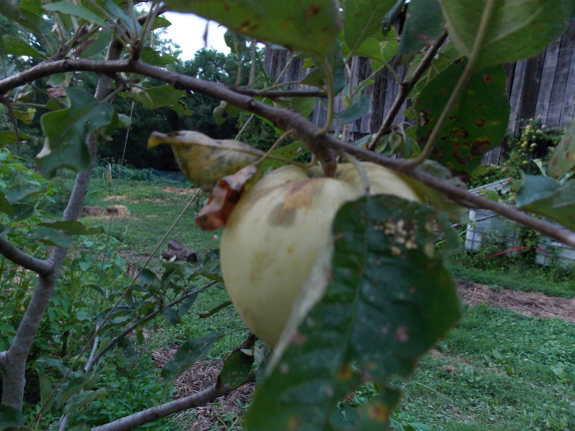
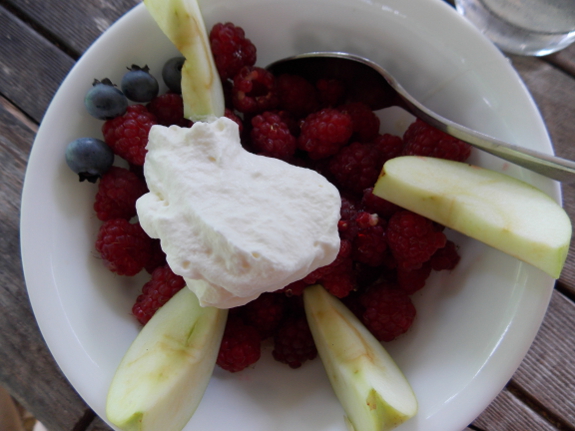 This is the first year
we've been awash
in homegrown fruit, and one of the things I'm noticing is that small changes in
growing methods result in large changes in fruit flavor. For
example, we have two rows of Caroline red raspberries, one in full
sun in poor soil and one in partial sun in good soil. The
latter produced fewer berries, but their flavor was exceptionally
good, while the plants in poor soil churned out plenty of berries
with only good flavor.
This is the first year
we've been awash
in homegrown fruit, and one of the things I'm noticing is that small changes in
growing methods result in large changes in fruit flavor. For
example, we have two rows of Caroline red raspberries, one in full
sun in poor soil and one in partial sun in good soil. The
latter produced fewer berries, but their flavor was exceptionally
good, while the plants in poor soil churned out plenty of berries
with only good flavor.
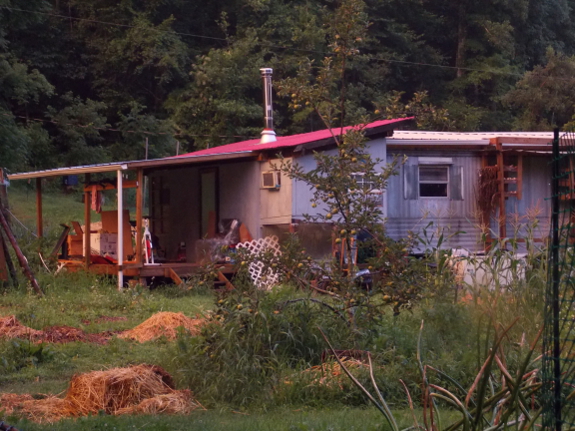
Then there are the
apples. I specifically included one variety in my high-density
planting that
was also getting ready to bear in the forest garden so we could
see if the production method influenced flavor of the fruit.
The high-density Yellow
Transparent apples ripened about a week earlier than those in the forest garden
and were quite tasty. And then we sampled the forest garden
fruit --- wow! Such a rich flavor! It's still pretty
amazing to be able to eat homegrown apples in one year (and to try
out lots of different varieties in a small space), but over the
long haul, it's definitely also worth putting in larger trees with
complex soil management if you want the more intricate flavors.
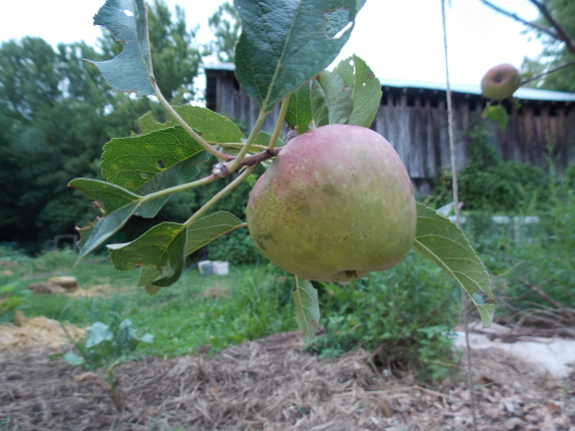
 My final observation came
with our peaches. Even though I
prune our trees hard and thin religiously, a few fruits still
ended up closer together or deep in the shade of the tree and
remained small. These small peaches ripened a little later
than the big, beautiful peaches, and they were only a fraction as
sweet. I'd actually be tempted to thin out the
partially-shaded peaches in later years to let the tree put all
its energy into the prime fruits in the outer canopy --- they were
that much better.
My final observation came
with our peaches. Even though I
prune our trees hard and thin religiously, a few fruits still
ended up closer together or deep in the shade of the tree and
remained small. These small peaches ripened a little later
than the big, beautiful peaches, and they were only a fraction as
sweet. I'd actually be tempted to thin out the
partially-shaded peaches in later years to let the tree put all
its energy into the prime fruits in the outer canopy --- they were
that much better.
All of that said,
even the worst of our fruit this year has tasted much better than
store bought. Still, if we can produce yet more delicious
fruit with just a few management changes, why not do it?
I've been trying out a new kind of flat bungee cord that seems better suited at securing containers like these baby fig trees than the round ones that tend to roll and sometimes shift out of place.
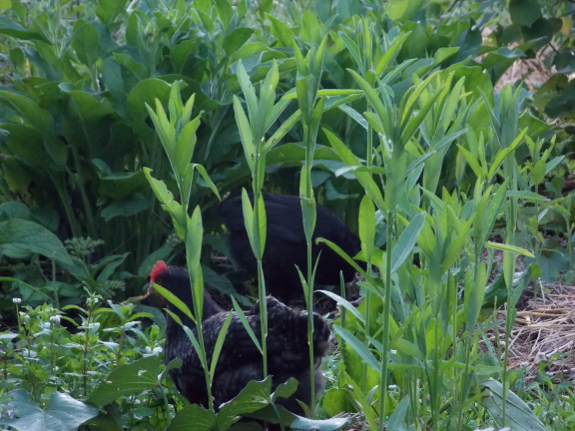
I've been trying lots
of cover crops this year, and even though the results aren't in, I
thought I'd write a midterm sum up. The image above is from
the forest garden, where I planted sunn
hemp (the tall
things in the foreground), sunflowers, and sweet potatoes as cover
crops in the last few weeks.
The sunn hemp is
growing great in good soil, but is struggling (as most things do)
in poor soil with high groundwater. The sweet potatoes seem
to be doing well everywhere, and have the major bonus that I can
plant a single set and then expect it to grow exponentially
despite the troublesome trio of chicks who have been roaming the
garden lately. The sunflower seeds, I'm sad to say, all went
down those chicks' gullets. (More on the drama of the chicks
coming up over on our chicken blog.)
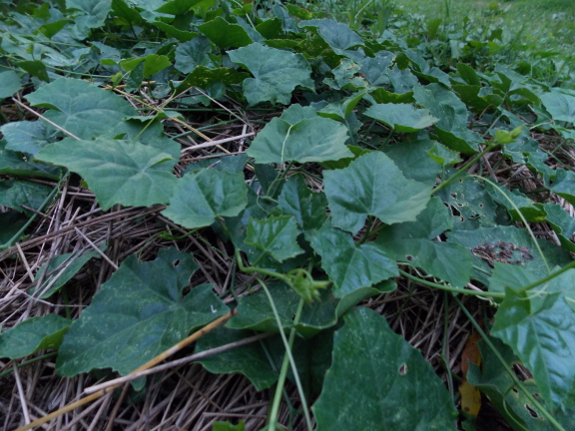
Even though I put it
in as a vegetable, I'm now considering this perennial
cucumber (sent to us by a kind reader) to be a cover
crop. Despite its name, the plant has yet to fruit for us,
probably because it doesn't like living in the land of all rain
and no sun. I won't repeat this experiment since it's not
worth keeping a cutting over the winter just for biomass
production, but the cucumber does seem to be covering bare soil
well (and also growing up into my trees).
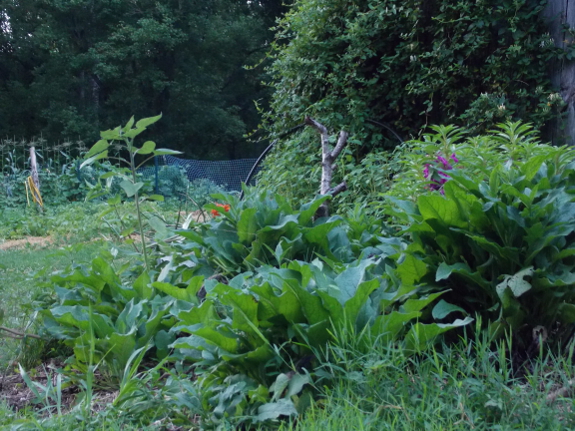
Although not a cover
crop, I thought I'd show you my comfrey bed, turned flower
garden. Last winter, I
ripped out every single plant and root I could find to
transplant to a chicken pasture, but of course the comfrey
came back with a vengeance from the root fragments left
behind. I ripped the new plants back to the ground once this
spring and planted annual flowers in the gaps, then ripped the
comfrey back again to give those flowers a chance to bloom.
Looks like I'm due for another ripping job. The nearby plum
trees are enjoying their monthly doses of comfrey mulch.
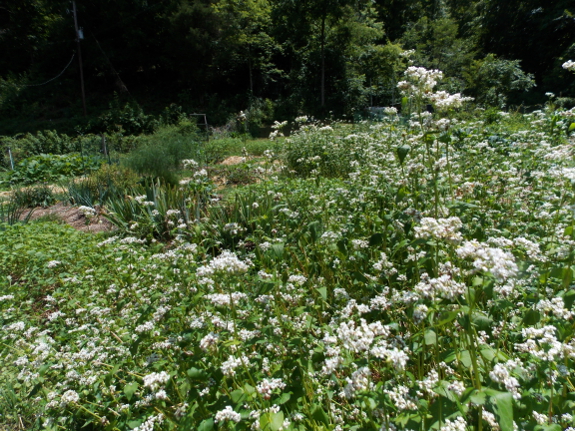
In the main vegetable
garden, I'm playing it safe and just filling gaps with my trusty
standby --- buckwheat. The bees (wild and cultivated) adore
the flowers, and it's always a joy to pull up buckwheat just
before planting time. I end up with free mulch to cover
perhaps a quarter of the bed, along with nearly weed-free ground
for my seedlings to enjoy. While the other cover crops
mentioned in this post are experimental play, the buckwheat is tried
and true.
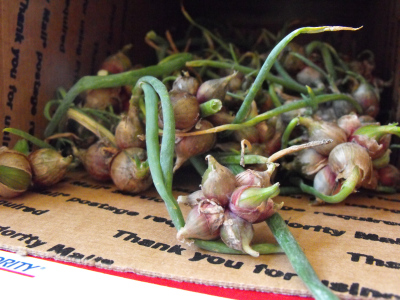 I know that some of you missed out on
our lightning-fast
Egyptian-onion giveaway this year and still wanted to try these perennial onions
in your garden, so I saved back a bunch of bottom bulbs and Daddy
harvested his top bulbs to prepare for another giveaway.
This giveaway is much different than our usual, so please read
through all of the rules below before entering. (And don't
skip this post if you aren't interested in Egyptian onions ---
I'll give you a signed copy of The
Weekend Homesteader instead if you win and aren't an onion
person.)
I know that some of you missed out on
our lightning-fast
Egyptian-onion giveaway this year and still wanted to try these perennial onions
in your garden, so I saved back a bunch of bottom bulbs and Daddy
harvested his top bulbs to prepare for another giveaway.
This giveaway is much different than our usual, so please read
through all of the rules below before entering. (And don't
skip this post if you aren't interested in Egyptian onions ---
I'll give you a signed copy of The
Weekend Homesteader instead if you win and aren't an onion
person.)
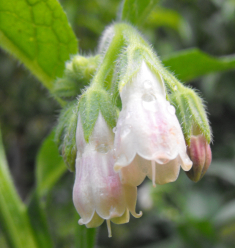 Background
Background
A couple of months
ago, I started thinking about how so much of the
permaculture-education material I read and watch is theoretical,
which really bogs down the beginner. Wouldn't it be
wonderful if there was a resource showing permaculture techniques
that have succeeded or failed in real, hands-on
applications? I can come up with lots of examples in my own
garden, but I'd love to hear from the larger permaculture
community.
How
to enter
Your entry in this
giveaway will consist of an email to anna@kitenet.net with a concise but
complete explanation of a permaculture technique you've tried out
and why it did or didn't work for you. If you don't want to
write about a specific technique, you can instead write about how
your homestead exemplifies one of the twelve
permaculture principles.
In either case,
please include your location, your gardening zone, at least one
photo (more is better), and anything else you consider
relevant. I'll want to be able to use your information on
this blog and perhaps in an ebook, so by entering, you'll be
agreeing to allow me to make use of your text and images with no
further compensation. (I don't mind if you use the same
information elsewhere, though, which I think means you're
licensing your intellectual property under a Creative
Commons Attribution 3.0 Unported License.) Please let me know if
you'd rather remain anonymous or whether I can use your first
and/or last name when attributing your work as well.
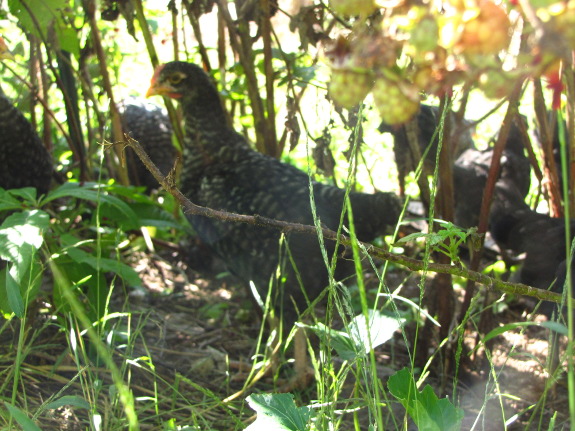 Winners
Winners
All entries must hit
my email inbox by July 31 at midnight, and once they're in, I'll
pick my favorites. Depending on how many boxes of onions we
have (at least six and probably quite a lot more), everyone may
win, or only the best entries may get prizes. And, as I
mentioned above, I'll mail you a signed copy of my book instead if
you win and would rather read than plant.
I'm looking forward
to hearing about your permaculture experiments!
Thank you Roland, tee and
Eric for the corner
bracket feedback.
It only took a minute to add
this outer bracket.
The wood is just under an
inch, so I installed the one inch screws at a slight angle to prevent
them from poking out on the other side.
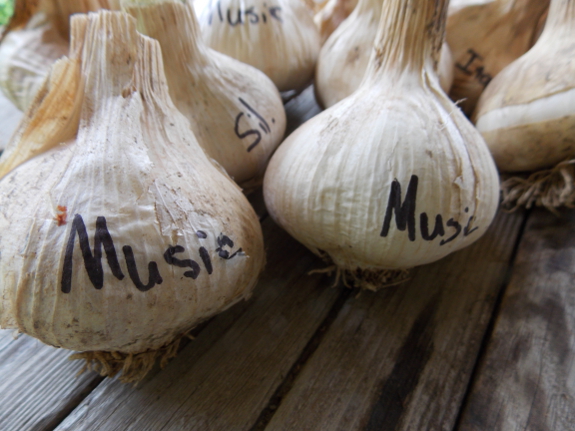
This
is far from our best garlic year, with the total harvest being a mere 17
pounds. Still, we'll have enough to plant and to eat,
although not the usual 10 pounds extra to give away. Unlike
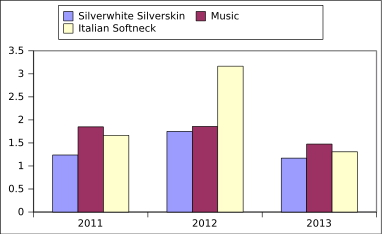 most years, we're also eating down to the
dregs of the previous year's crop before starting on the 2013
garlic to make sure they stretch for the full season.
most years, we're also eating down to the
dregs of the previous year's crop before starting on the 2013
garlic to make sure they stretch for the full season.
Since I think weather
was the main reason our harvest was mediocre, we're not changing
anything for next year's planting, although I did think of one
minor innovation. Writing the name of each variety on my
seed garlic makes the heads easy to store all together rather than
in individually-labeled bags, and should make management during
planting a breeze. These seed heads --- the largest and
best-looking ones of the crop --- will sit in a mesh bag for two
months, then will go in the ground in late September as one of our
last crops of the year.
I recently posted about a new
source of Ethanol free fuel at a nearby Kwik-Way station that has me wondering if
it was really Ethanol free. My only evidence is a bit of sputtering and
a few back-fires from the ATV.
The new plan is to use Sta-Bil in fuel that sits in the
tank for longer than a week.
A friend of mine suggested
that some stations advertise Ethanol free fuel just to bring in people
like me. He claims it all comes from the same place in Knoxville no
matter what company name is on the side of the tanker.
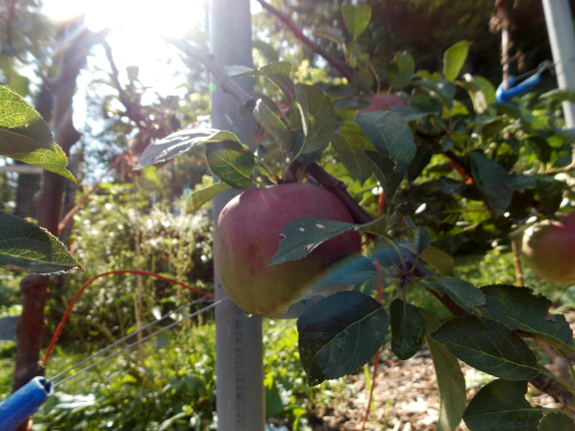
Although the fruits
are delicious, my favorite part of adding high-density
apples to our
homestead is the way they prompt me to pay more attention to our
other perennials. Usually, I'm lucky to make one summer pruning pass through the
perennials each season, but since I have the high-density apples
on my monthly list, I've been going ahead and taking a look at
everyone else while I'm at it. Kayla's hard work weeding,
processing garlic, and generally being an energetic and pleasant
presence in the garden has also been essential in giving me time
to check on the perennials more. (Thank you, Kayla!)
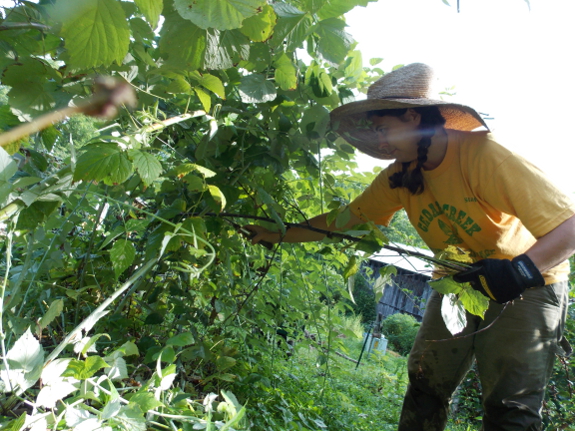
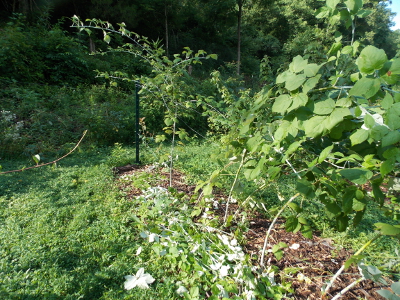 Which is why I spent Tuesday following up on
last
month's raspberry pruning. The reds and blacks are
both done fruiting (although the former are already setting new
berries for fall), so this year's floricanes can come out.
Usually, I wait until winter to remove the used-up canes, but it
seems like acting sooner can only help by giving the new canes a
bit more light and air. Old, branched canes end up in our brush
pile, while the
smaller primocanes that I decided not to keep wilt down nicely
into mulch if placed along the sides of the beds.
Which is why I spent Tuesday following up on
last
month's raspberry pruning. The reds and blacks are
both done fruiting (although the former are already setting new
berries for fall), so this year's floricanes can come out.
Usually, I wait until winter to remove the used-up canes, but it
seems like acting sooner can only help by giving the new canes a
bit more light and air. Old, branched canes end up in our brush
pile, while the
smaller primocanes that I decided not to keep wilt down nicely
into mulch if placed along the sides of the beds.
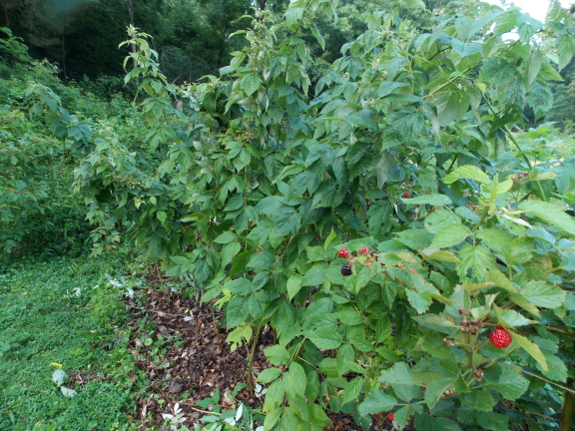
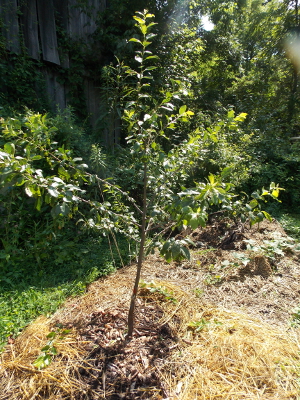 Now's also a good time to
tie up those new, vigorous canes so we don't end up picking
berries from a sitting position the way I had to on some plants
this year. This will also keep the berries out of the way of
the lawnmower and out of the rot zone close to the damp ground.
Now's also a good time to
tie up those new, vigorous canes so we don't end up picking
berries from a sitting position the way I had to on some plants
this year. This will also keep the berries out of the way of
the lawnmower and out of the rot zone close to the damp ground.
As you can see in the
foreground of the photo above, the blackberries are in full
production mode, so I left them alone. Next month during our
apple-training day, I'll prune out the old blackberry canes and
tidy up the beds like I did for the raspberries this week.
But for now, it's time to move on to training our new plums and
our frameworked
pears.
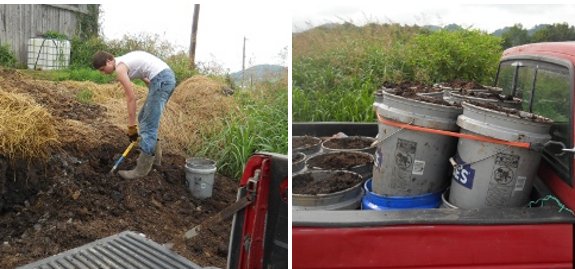
Our new helper Matt helped me
figure out today that the new flat bungee
strap is just the right
size and elasticity to hold the 7 extra buckets of manure I've been
stacking in the truck.
The ratchet strap tended to
come loose after the short drive back and has a bit of a learning curve
for new users like Matt.
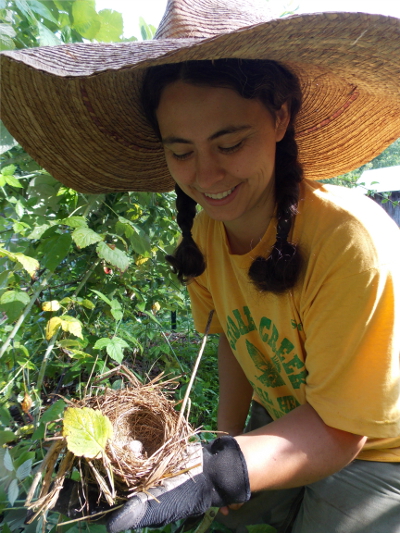 One of our resident song sparrows hasn't been
having a good year. It seems like every time she builds
a nest and fills it with eggs, I accidentally impact it
while gardening, then the mother bird abandons her offspring.
One of our resident song sparrows hasn't been
having a good year. It seems like every time she builds
a nest and fills it with eggs, I accidentally impact it
while gardening, then the mother bird abandons her offspring.
As much as we'd like
to allow her to hatch some chicks, Mark pointed out that there's
no reason to let abandoned sparrow eggs go to waste. So when
the third nest came out with some raspberry primocanes, I decided
to add the sole egg to our lunch.
I boiled the sparrow
egg up while cooking sweet corn, let the egg cool slightly, then
shelled it out and put the tiny morsel on top of our Swiss
chard. The egg was nearly entirely yolk and tasted
delicious...perhaps because of the garlic butter it soaked up.
Granted, sparrow eggs
will remain in our survival-food category despite the
flavor. After all, it would take about a dozen of them to
make one chicken egg, and who wants to negatively impact the local
song-bird population? But if I find more abandoned nests
around, I'll definitely cook up the bounty.
I
think it's possible I may have caused some carburetor damage by not
shutting off the fuel switch when we stable her.
Someone once told me you only
needed to do that when transporting, but several comments on an ATV
forum says shutting it off can avoid needle damage.
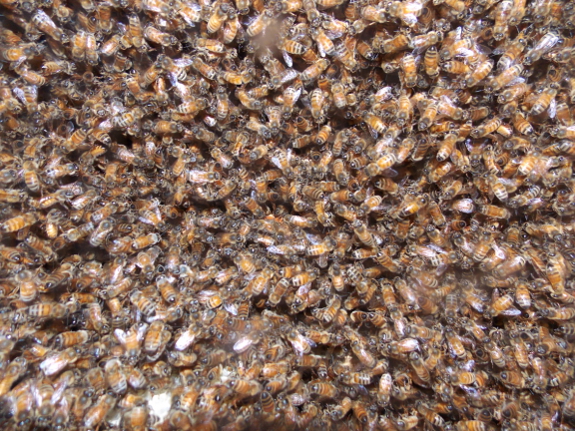
The
package we installed at the beginning of June consumed a lot of sugar
water at first, slowed down a bit, then a week or two ago began
taking nearly a quart a day again. Since the
swarm we captured a few weeks later didn't show the same trend of increasing
their sugar-water consumption recently, I figured that meant our
package was building new comb. Sure enough, a photo up
through the bottom of the hive on Monday showed bee activity in
the lower box for the first time.
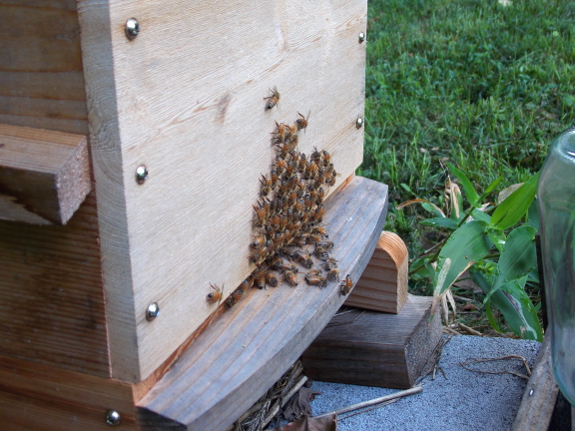
On Thursday morning,
I noticed bees bearding on the outside of that hive.
Bearding can mean the hive is too hot, but since these bees were
bearding first thing on a cool morning, I suspected it was instead
a sign of congestion inside the hive. I'd go sit on the
porch too if I was sharing an apartment with tens of thousands of
roommates.
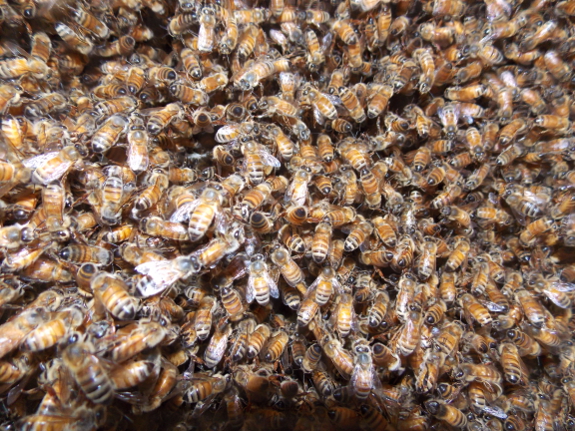
Sure enough, a photo
up through the bottom on Thursday showed even more bees in the
lower box. When I take a photo up into a hive, I stick my
camera directly on the screen and don't zoom, so you can tell how
close the bees are to the camera by size. They look about
twice as big in the photo above compared to the one at the top of
this post, so I'm guessing the bees were nearly touching the
screen when this second photo was taken. While there are too
many bees to guess how much of the second box is now full of drawn
comb, I figured it was time to expand their living space.
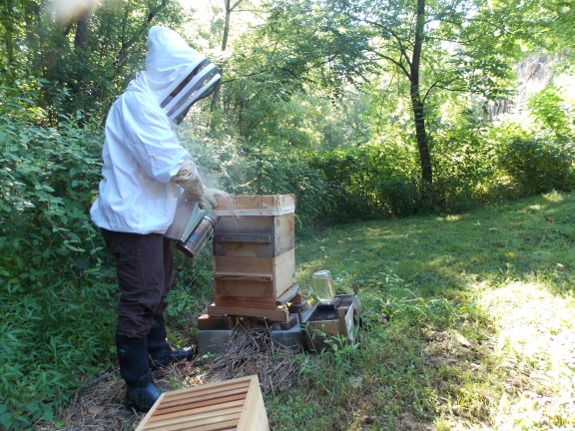
I snuck a bit of
smoke under the quilt as well as in the entrance, and was then
able to lift the two boxes plus quilt to the side and add a new
box underneath without straining myself or bothering the
bees. Kayla came along to take the photo above (and to get a
bit of experience since she's considering embarking on
beekeeping), and was amazed at how calm the bees acted. This
set of bees is definitely my nicest hive --- I have to plop the
sugar water in the entrance feeder and run to prevent suiting up
when visiting our barn swarm.
There are small signs of
blight on a tomato plant near our wet gully, but all the other plants
with experimental
copper mesh protection
are happy and blight free.
It's been a very wet summer,
and maybe without the copper we would be seeing more blight spots?
I'll post an update to this
experiment in a few weeks.
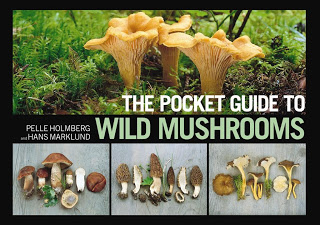 My publisher sent me a copy of The
Pocket Guide to Wild Mushrooms to review, and I'd highly recommend this book to
anyone hunting for edible mushrooms...as long as you live in the
right area. The authors, Pelle Holmberg and Hans Marklund, chose fifty of the best
edible species, then broke them down into categories based on how
easy they would be to confuse with poisonous mushrooms. Each
species description contains two photos, one of the mushroom in
the wild, and the other a very well-done studio shot containing
various stages of the mushroom's life cycle.
My publisher sent me a copy of The
Pocket Guide to Wild Mushrooms to review, and I'd highly recommend this book to
anyone hunting for edible mushrooms...as long as you live in the
right area. The authors, Pelle Holmberg and Hans Marklund, chose fifty of the best
edible species, then broke them down into categories based on how
easy they would be to confuse with poisonous mushrooms. Each
species description contains two photos, one of the mushroom in
the wild, and the other a very well-done studio shot containing
various stages of the mushroom's life cycle.
The down-side of the
field guide is that it's probably not useful to most of my
readers. The authors don't come out and say this, but I'm
guessing from context that they're from Sweden, and most of the
mushrooms 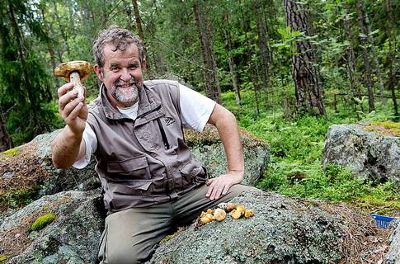 are listed as living in
coniferous northern forests of North America and Europe. In
other words, if you live far enough south that your dominant trees
have broad leaves instead of needles, you're mostly out of luck.
are listed as living in
coniferous northern forests of North America and Europe. In
other words, if you live far enough south that your dominant trees
have broad leaves instead of needles, you're mostly out of luck.
While The Pocket Guide to Wild
Mushrooms won't be finding a permanent spot on my
bookshelf, the book did provide a bit of interesting
information. Did you know that most of the flavors in
mushrooms are fat soluble, so your mushrooms will taste much
better if you saute them in butter than if you boil them in
water? And that, in the era before farmers provided mineral
blocks, cows used to rush into the woods at certain times of the
year to consume large quantities of mushrooms, presumably as a
mineral boost?
I'm still hunting for
the best guide for foraging edible mushrooms in our area, and am
open to suggestions. Mushrooms
Demystified and
the Audubon
Society Field Guide to Mushrooms are good, but the former has a western focus
and both are general field guides without an emphasis on
edibility. Do you have a better field guide for finding
edible mushrooms in the wild?
The first pond turned out so well we decided to make another to deal with gutter runoff at the other end of the trailer.
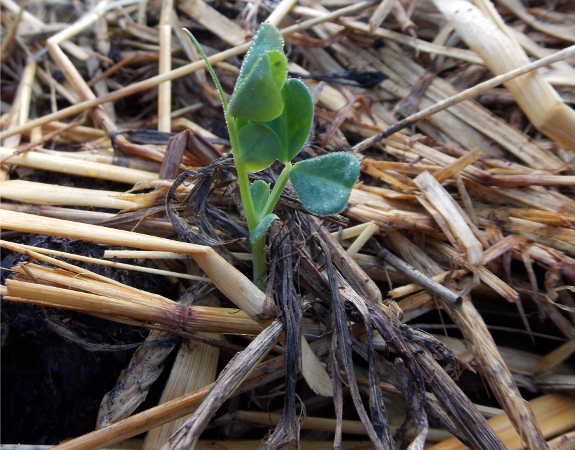
This rainy summer has
been problematic in some ways, but handy in others. For
example, the tiny persimmon trees I set out in our pastures last
fall have been thriving despite my usual summer neglect of
anything not in the vegetable garden. June bugs have been
leaving our blackberries alone for the first time ever. And
the seeds of fall crops are sprouting with no extra effort on our
part.
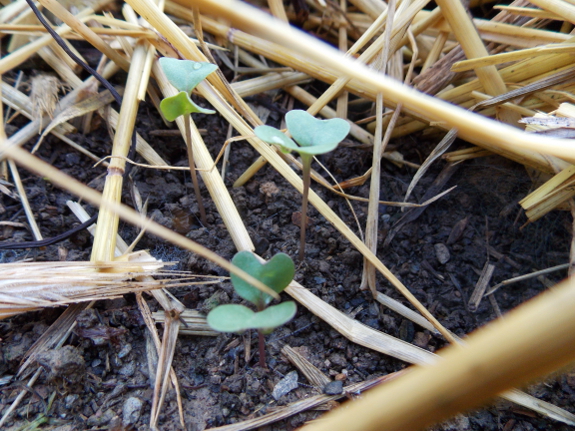
Actually, I dutifully
started a round of fall cabbages, broccoli, and brussels sprouts
on the porch, only to have a mouse come along and nibble off every
cotyledon. (That's what I get for storing cover crop seeds
in the open near my seed-starting area.) But then I realized
that the only reason I
started the fall crucifers in flats last summer is because it was too
hot and dry to sprout them in situ. So I poked a bunch of
little round seeds in the ground right where I wanted my crops to
grow and waited for the copious rain to make things sprout.
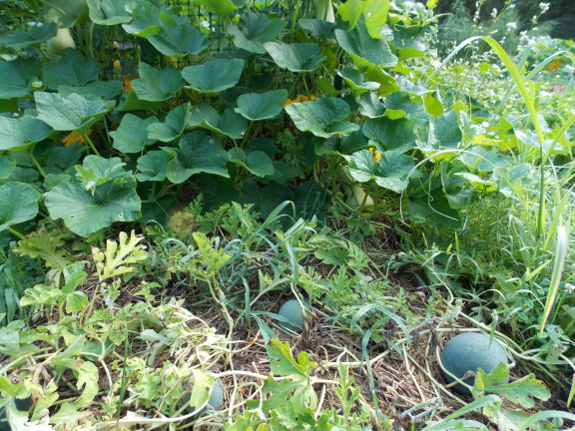
On the negative side,
we had an unexpected problem that was linked to the rain in a
roundabout way. I've read that you shouldn't water your
garden every day, because then the roots stay close to the surface
and your plants wilt if there's a drought. What I didn't
realize is that a sodden June and July had the same effect on our
crops, so when we actually spent a week at normally hot
temperatures with no rain, our watermelons nearly died. Good
thing I had one patch in a different spot where they were subirrigated
by the swamp resulting from roof runoff.
I hope your fall
crops are up and running like (most of) ours are. Autumn is
looming on the horizon and pretty soon, it'll be too late to plant
anything except leafy greens and winter cover crops.
There are several ways to get
a dirt hole to retain water, but we usually like to start with the
least expensive methods and then work our way up if necessary.
Anna's first attempt includes
a layer of jewel weed and generous foot stomping to compact the future
pond floor.
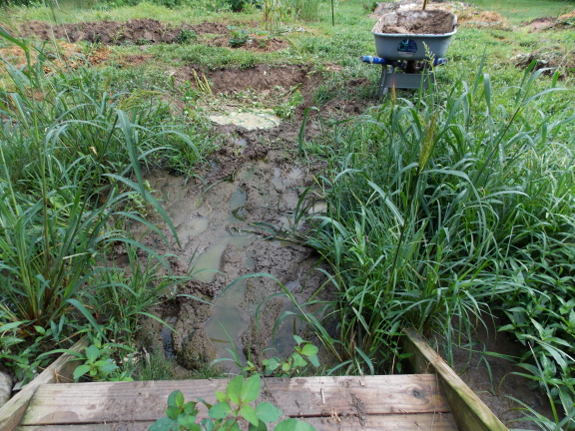
While the honest
truth is that I just like digging holes and playing in the mud, I
do have a plan surrounding our newest
pond experiment.
The photo above shows the swamp you have to wade through when
leaving the north side of the East Wing porch. The
groundwater is close to the surface there and all of the rain
pouring off the roof results in a waterlogged mess. My
general goal in our core homestead is to never have to slog
through the mud, so I need to channel that water somewhere out of
the way.
(Gerry asked why we
don't just install a rain barrel under that gutter. While
his idea has merit for the dry season, we'd still have to deal
with overflow from the rain barrel when we don't have a use for
the water. So it makes sense to figure out where that
overflow will go now.)
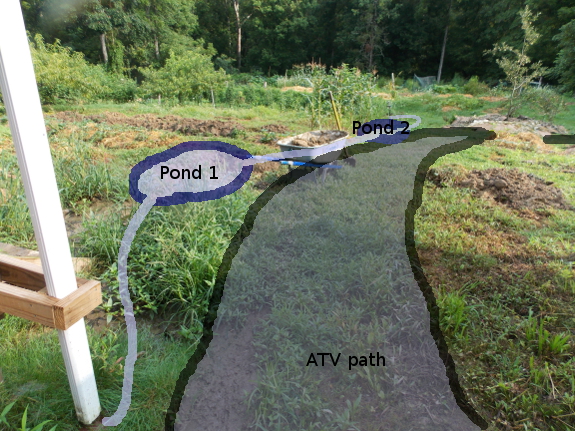
So what's my plan for
the excess water? Mark recently decided to make an ATV loop
around the forest garden so it would be easier to drop off manure
and straw by the barn, and I want to leave that driveway area open
(and hopefully dry). To that end, I plan to attach the
gutter downspout to a lightly buried pipe heading to our current
pond excavation, then I suspect I'll have to bury an overflow from
that pond leading to another little pond halfway down the
hill. From there, I'm prepared to channel extra overflow
into the gully.
The jury's still out
on whether my ponds will hold water. (More on my experiments
with sealing in a later post.) And I'm curious to see
whether they'll make the surrounding soil more or less
soggy. But I'm planning the pond locations carefully to keep
them away from major thoroughfares, so at worst they'll serve
their primary purpose of getting the mud away from the steps.
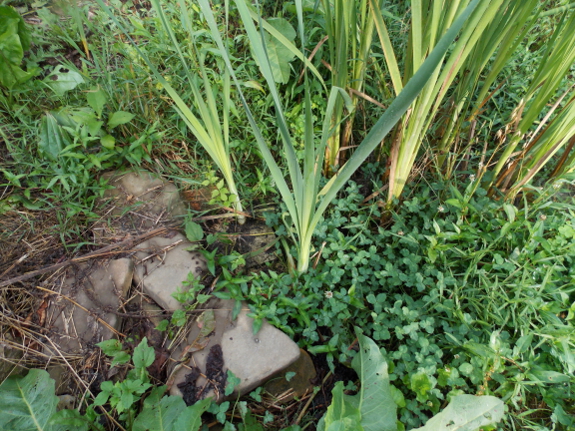
Speaking of keeping
water away from steps, our greywater
wetland is serving that purpose admirably. Mark called
it a stellar success, and while there are a few things I want to
change in this second incarnation, I'm quite happy with the
complete absence of muck and smells. (The swamp gas wafting
up into our kitchen sink in June disappeared with no work on our
part a couple of weeks after appearing. My best guess is
that some kind of good microbial community came in to overrun the
bad one, but I don't really know what happened for sure.)
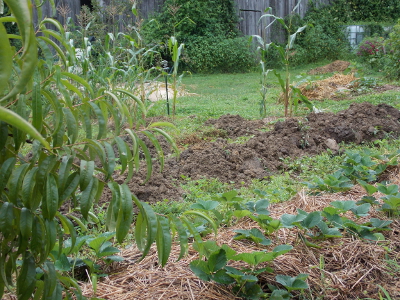 What don't I like about
version 1.0? I mounded up the excavated soil to make big
walls around the wetland, which makes it tough to mow (Mark uses a
weedeater) and makes the whole thing stick out of the landscape a
bit. For version 2.0, I'm instead using the dug-out earth to
raise up garden beds in the waterlogged back garden.
What don't I like about
version 1.0? I mounded up the excavated soil to make big
walls around the wetland, which makes it tough to mow (Mark uses a
weedeater) and makes the whole thing stick out of the landscape a
bit. For version 2.0, I'm instead using the dug-out earth to
raise up garden beds in the waterlogged back garden.
And while I didn't
want standing water in the greywater wetland, I'm hoping to make
version 2.0 into a pond instead of a marsh. The cleaner
water coming off the roof won't be problematic in the form of open
water, and my lotus has sent out a runner that needs a new
home. So now it's time to think of step two --- sealing my
clay pit.
 Our
most-watched Youtube video details the construction of our
first-generation fridge root cellar, and we posted about our
second-generation root cellar several times over the course of the
last year. People are constantly asking for more
information, so I decided to sum up everything we've learned in an
ebook.
Our
most-watched Youtube video details the construction of our
first-generation fridge root cellar, and we posted about our
second-generation root cellar several times over the course of the
last year. People are constantly asking for more
information, so I decided to sum up everything we've learned in an
ebook.
I'll post
highlights here over the course of the week, or you can buy
your own copy on Amazon (which can
be
read on
nearly any device.) I apologize for the higher price --- this ebook is
very photo-rich, so Amazon wouldn't let me sell it for less than
$1.99.
Here's the blurb:
The easiest way to grow more of your own calories is to focus on roots like potatoes and carrots. With yields of up to 200 calories per square foot, you can break your reliance on the grocery store with just a few seeds or starts and a shovel. Most root crops are easy to store through the winter and require no special harvesting or processing equipment.
So why don't we all grow roots? To keep them happy after harvest, these crops need a cool, damp storage spot like a root cellar. This book walks you through building a root cellar out of a junked fridge for $10, and also presents some slightly-higher-cost options for winter storage. Other highlights include tips for growing storage vegetables and feeding those roots to your family or your livestock.
69 photos.
Self-sufficiency begins with the potato!
As usual, I'll
also make the ebook free on Amazon on Friday for those
who want to wait for a free copy, and you can email me Friday for
a
free pdf copy as well. Thanks for reading (and
double thanks if you find the time to leave a review on Amazon)!
| This
post is part of our $10
Root Cellar lunchtime series.
Read all of the entries: |
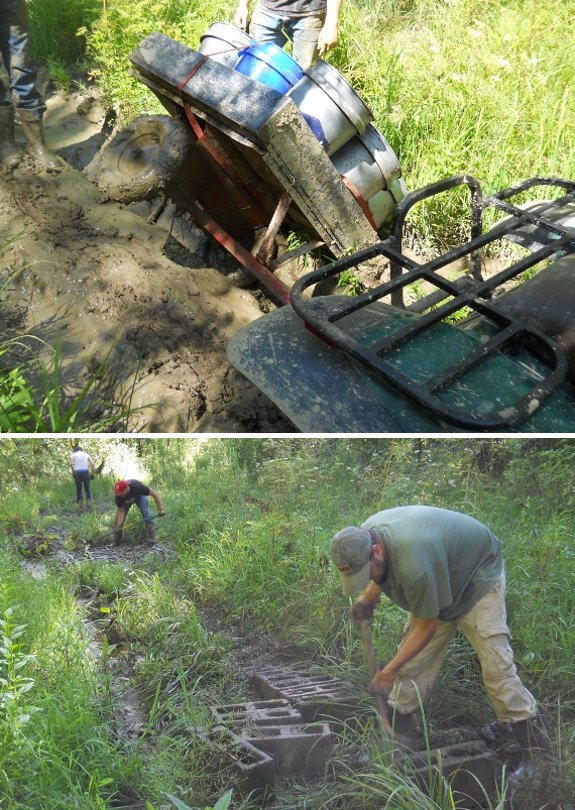
The driveway ruts have been
getting extreme enough to cause the bucket
hauler to tip over.
It took two of us to tip it
back fully loaded with buckets of horse manure.
Luckily it's still Summer
break around here which lets us take advantage of some hard working
teenage labor to get some cinder blocks placed in the old ruts.
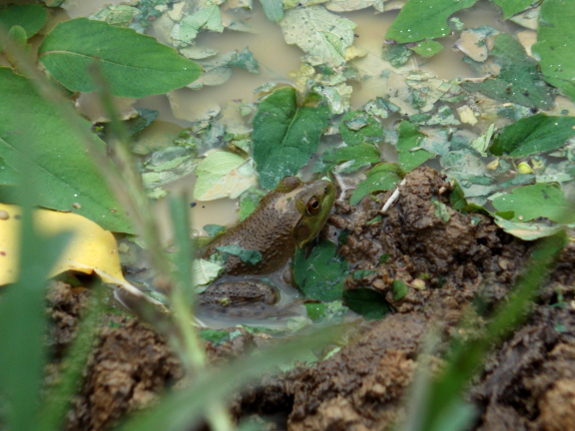
Although a little
frog moved into my pond
excavation overnight, I know the water level is currently
dependent on groundwater height. In other words, if it ever
stops raining constantly, our groundwater will drop and our "pond"
will dry up. Time to experiment with sealing the pond!
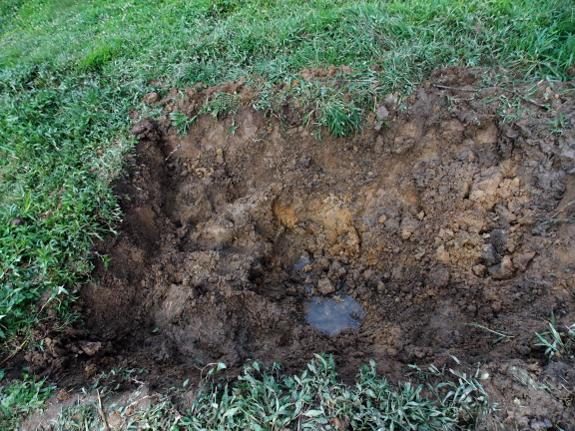
From what I've read,
the first step in making a liner-less pond that will stay wet is
to choose the right area where the soil is rich in clay and the
groundwater is high. That part's easy in our swamp. As
I dug my hole Saturday evening, I could tell I was hitting
groundwater because the mud on my shovel became nearly too heavy
for me to lift. An hour after stopping, water was already
trickling in to fill the hole.
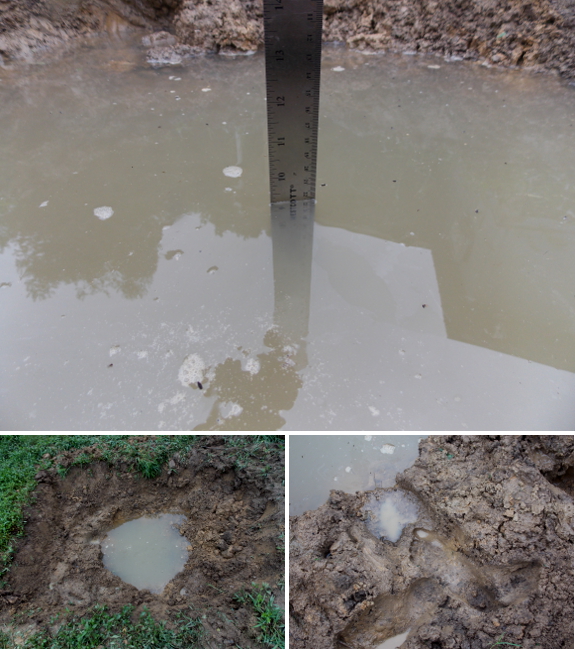
By Sunday morning,
the pond had filled to a depth of nine inches. It did rain
in the night, but only lightly, and I'm sure the majority of this
water simply seeped into my pit through the walls.
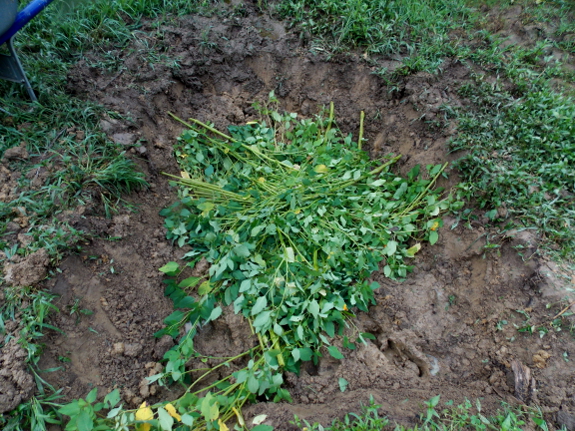
Found water is
exciting, but I want my pit to hold water even during
droughts. And I'd prefer it to be fillable above the
groundwater level. In Earth
Ponds, Tim
Matson reports that most liner-less ponds nowadays achieve their
water-holding abilities by compacting the soil with heavy
equipment. But before we had bulldozers, people were still
building ponds. As the water slowly seeped into the hole,
these old-timey farmers turned livestock into the pond area and
let them trample the mud with their hooves, sometimes adding hay
and/or manure to combine gleying action with the
compaction. They often had to repeat the procedure at
intervals as water levels rose.
We don't have a handy
herd of cattle (and I don't think you could fit even one cow in my
little hole), so I decided to mimic their action myself.
Rather than hay, I tossed in an armload of jewelweed...
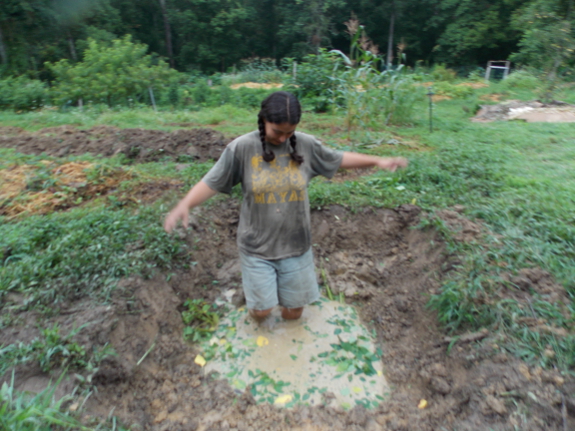
...and jumped in to
trample the organic matter into the mud!
Here's where I
realized one flaw in my pond design. I wanted to make the
bottom deep and to provide a shallower ledge around that center
for emergent plants, but my pond is too small to provide a gentle
slope between the two levels. As I trampled, I realized I'd
be able to seal the bottom of each tier, but not the steep walls
in between. We'll see if this dooms my project to leaky
failure.
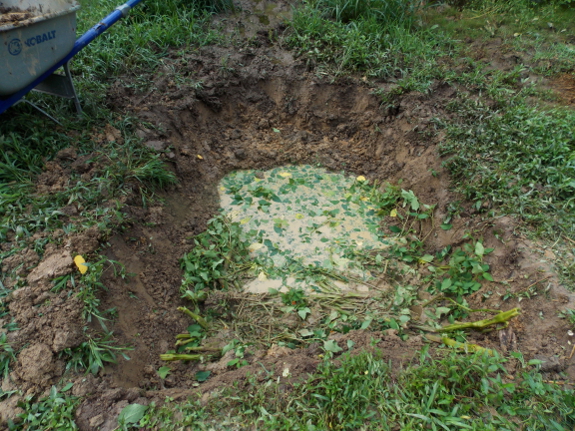
Here's my jewelweed
fermentation pit after trampling an armload of greenery into the
water-holding portion and another into the soggy tier closest to
the camera. If the water level continues to rise, I'll
repeat the endeavor with other parts of the pit.
I'm having fun
experimenting with small-scale pond sealing, but I'm also prepared
to change over to a liner if necessary. In my mind, this
pond is already full of lotuses, arrowheads, and goldfish, and I'm
prepared to drop $100 to make that happen.
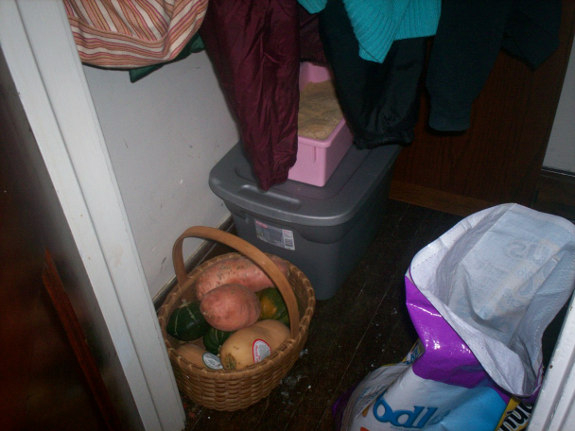
Since I'm assuming
you've all been following our fridge root cellar adventures here
on the blog, the excerpts from $10
Root Cellar that I plan to share this week are going to
cover other options for root storage. The simplest and
cheapest suggestion came from Aimee Leforte, who uses plastic
storage bins and sand to emulate root-cellar conditions.
I'll let her tell you about closet root storage in her own words:
"This particular closet has two walls that are also outer walls, and two walls that are inner walls. I have found in the late fall and winter that this closet is fairly cold, but definitely above freezing. If I had to guess I would say its in the 40-45 degree range; I haven't actually measured it.
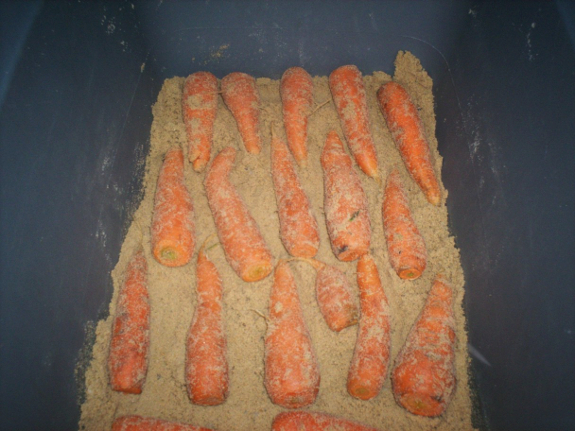
 "With carrots,
parsnips, and turnips, I have taken each and topped them.
Then I will take a tote and layer the bottom with
slightly-dampened sand. Layer in a layer of veggies so that
they are not touching. Add sand to build up a layer, mist
lightly with water, then add veggies again. I do this
several times until the tote is 3/4-of-the-way full. I add
the lid and store in the bottom of the closet.
"With carrots,
parsnips, and turnips, I have taken each and topped them.
Then I will take a tote and layer the bottom with
slightly-dampened sand. Layer in a layer of veggies so that
they are not touching. Add sand to build up a layer, mist
lightly with water, then add veggies again. I do this
several times until the tote is 3/4-of-the-way full. I add
the lid and store in the bottom of the closet."Every once in awhile, I'll check to see how they are doing. I've never had any go bad until at least late March, and have had farmer's market carrots from October clear until mid April.
"I think that this method, and a little experimentation, would work well for anyone who has a crawlspace, closet, or attached garage. Very simple to do. And I already had both the sand and totes, so for me it was free. But to buy these items you may have less that $15 to 20 dollars to set up one fair-size tote."
| This
post is part of our $10
Root Cellar lunchtime series.
Read all of the entries: |
My first attempt at MIG
welding the ATV hitch
receiver didn't go so well.
It broke loose after the
second horse manure delivery.
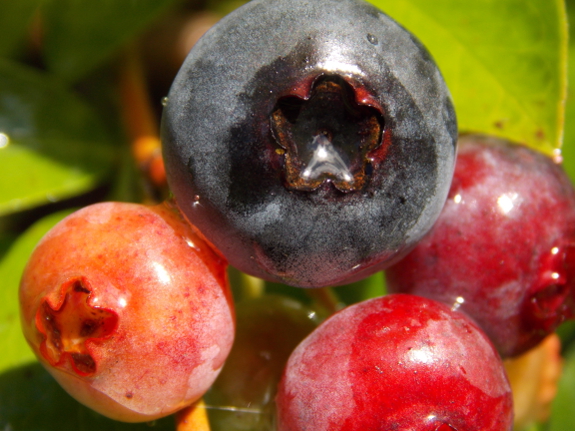
Most of our
blueberries were a wedding present, and while I vastly appreciated
the fact that my friends knew that fruit plants are the best gift
for me, I was a bit dubious that rabbiteyes would fare well here in
zone 6. The three plants I'd ordered for myself were all
northern highbush, which is what another
friend is growing just down the road with great results. However, when I
rated each of our bushes on a scale of 0 (dead) to 10 (huge and
covered with berries), I discovered that rabbiteyes just about
topped the variety list.
| Sulfur |
Pine needles |
Avg. health score |
Species |
|
| Southern
highbush |
10 |
10 |
10 |
hybrid |
| Climax |
10 |
5 |
7.5 |
rabbiteye |
| Delite |
8 |
3 |
5.5 |
rabbiteye |
| Briteblue |
6 |
1 |
3.5 |
rabbiteye |
| Herbert |
4 |
n.a. |
2 |
n. highbush |
| Brightwell |
3 |
0 |
1.5 |
rabbiteye |
| Austin |
2 |
3 |
2.5 |
rabbiteye |
| Atlantic |
3 |
n.a. |
1.5 |
n. highbush |
| Ivanhoe |
0 |
n.a. |
0 |
n. highbush |
| Average health score: |
5.1 |
3.7 |
4.4 |
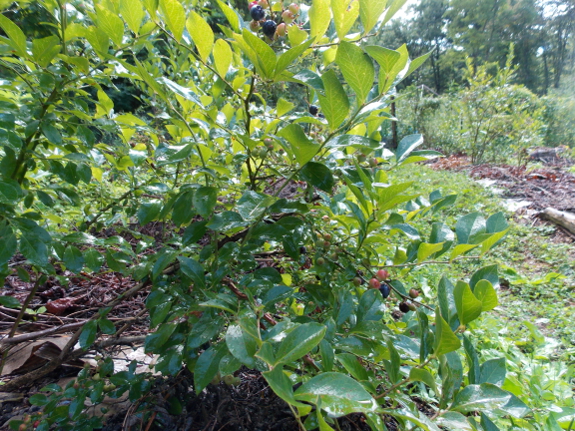
Who actually topped
the list? Southern highbush, which I originally thought was
a variety of rabbiteye, but which turns out to be a hybrid between
rabbiteye and northern highbush. This hybrid not only
produced beautiful bushes that are loaded with berries this year,
it also seems to be less sensitive to improper soil pH since even
the ground I treated
with pine needle leaf mold rather than sulfur yielded up a beautiful
bush.
Granted, this
comparison is a bit unfair to our northern highbush blueberries
since the northern species is supposed to be smaller than
rabbiteyes even when fully grown. For all I know, our
northern highbushes will shoot up in the next decade and meet or
beat the rabbiteyes. And it's also worth noting that our
northern highbushes produced their first berries a couple of weeks
before the southern highbush, who then beat out the rabbiteyes by
another week or so. So we might add more northern highbush
after all to help fill in fruiting
gaps.
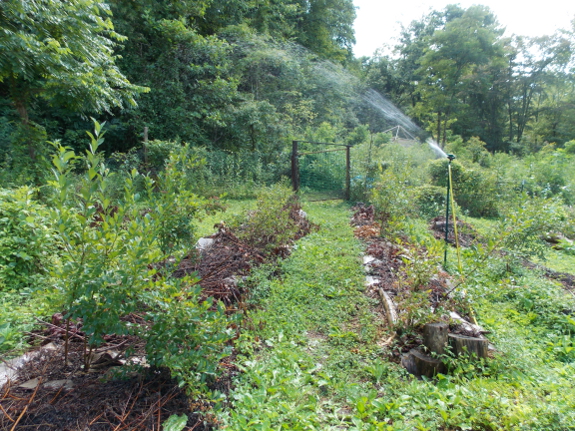
However, if you live
in our neck of the woods and are just looking for a couple of
top-producing blueberries to add to your garden, I'd heartily
recommend a southern highbush, followed by Climax and Delite among
the rabbiteyes. Plant now for 2017 crops!
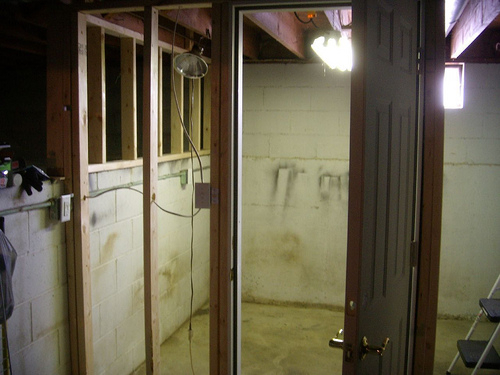
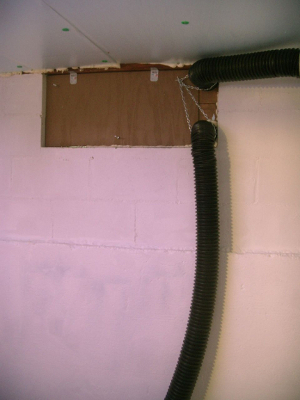 If you already have a
basement, you may be able to convert a small section over to
root-cellar conditions at a minimal cost. Emily Springfield spent $220 creating
a root cellar in her Michigan (zone 5b) basement. By
opening and closing the window to the outdoors, she could keep
potatoes and other root vegetables in good shape all winter
long.
If you already have a
basement, you may be able to convert a small section over to
root-cellar conditions at a minimal cost. Emily Springfield spent $220 creating
a root cellar in her Michigan (zone 5b) basement. By
opening and closing the window to the outdoors, she could keep
potatoes and other root vegetables in good shape all winter
long.The long version of Emily's renovation is detailed in $10 Root Cellar, but the short version is that she walled off and insulated a section of her basement. The trickiest part turned out to be ventilation, which she initially attempted using the pipe arrangement shown on the right. However, she soon found that the pipes weren't allowing cold air to flow in fast enough to keep the root cellar chilled. Emily's solution was to remove the pipes and simply open and close the whole window as needed. A thermometer in the root cellar with a remote readout in the kitchen made it easy to learn the way the root cellar responded to weather.
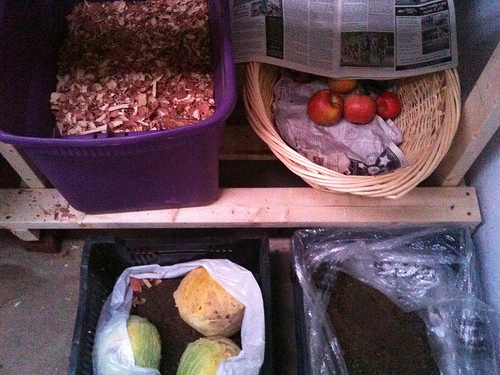
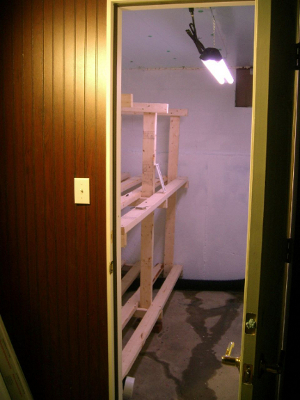 Emily's biggest trial with her
in-basement root cellar was humidity. "I can't seem to
get the humidity in the room to stay above 50% now that winter
has set in, even with bins of damp sand on the floor, so
instead I’m trying to keep the local humidity around the
produce high," she wrote. She experimented with storing
produce between layers of newspapers, straw, damp cedar
shavings, damp peat moss, and damp sand.
Emily's biggest trial with her
in-basement root cellar was humidity. "I can't seem to
get the humidity in the room to stay above 50% now that winter
has set in, even with bins of damp sand on the floor, so
instead I’m trying to keep the local humidity around the
produce high," she wrote. She experimented with storing
produce between layers of newspapers, straw, damp cedar
shavings, damp peat moss, and damp sand.Carrots and parsnips in straw didn't last long, beets did a bit better in damp cedar shavings, and potatoes seemed to prefer being stored between layers of newspaper in a basket. Cameo apples kept well under the same conditions as potatoes, with only a few on the edges going mealy by February. Rutabagas were more like beets (although a bit hardier), preferring the damp cedar shavings.
In February 2011, Emily concluded "Overall, I am very pleased with the root cellar I built last spring. It's keeping temperature well, not showing signs of mold or infestation, and
 most of the produce
is in very good shape." She added that the root cellar
was really far too big for a family of two (a 3-by-8-foot
structure would have been sufficient), but that "it was
actually easier to do it this way than to make it smaller."
most of the produce
is in very good shape." She added that the root cellar
was really far too big for a family of two (a 3-by-8-foot
structure would have been sufficient), but that "it was
actually easier to do it this way than to make it smaller."Since that report, Emily and her husband have moved away from their homemade root cellar. She wrote: "I love our new house (lots of passive solar features!) but I'm having a hard time living without a root cellar now! Anything stored in the unfinished-basement utility room is sprouting or going bad (too warm). I'm having better luck with stuff hanging out in cardboard boxes in the workroom (unheated detached garage), but I'm afraid if we get a cold snap it'll all freeze. So I may have to rebuild this root cellar at the new place. It'll be a little more difficult because I'll need to make a hole to the outside somehow, and that makes me nervous. But a cold room is so awesome to have, I may just have to figure that out!"
| This
post is part of our $10
Root Cellar lunchtime series.
Read all of the entries: |
Thank you Joe and David for
the comments on yesterday's
welding post.
More cleaning and grinding of
the surface area along with a bump up in the amp setting might get me
closer to a stronger weld, but I think my main issue is lack of
practice.
Having Anna flip down the
welding mask window when I'm ready might help. I feel like each
time I closed the window my placement would shift.
Grounding the frame of the
ATV sounds like a good precaution to prevent stray currents from doing
any electrical damage. I can't believe I forgot that detail!
Want more in-depth information? Browse through our books.
Or explore more posts by date or by subject.
About us: Anna Hess and Mark Hamilton spent over a decade living self-sufficiently in the mountains of Virginia before moving north to start over from scratch in the foothills of Ohio. They've experimented with permaculture, no-till gardening, trailersteading, home-based microbusinesses and much more, writing about their adventures in both blogs and books.

